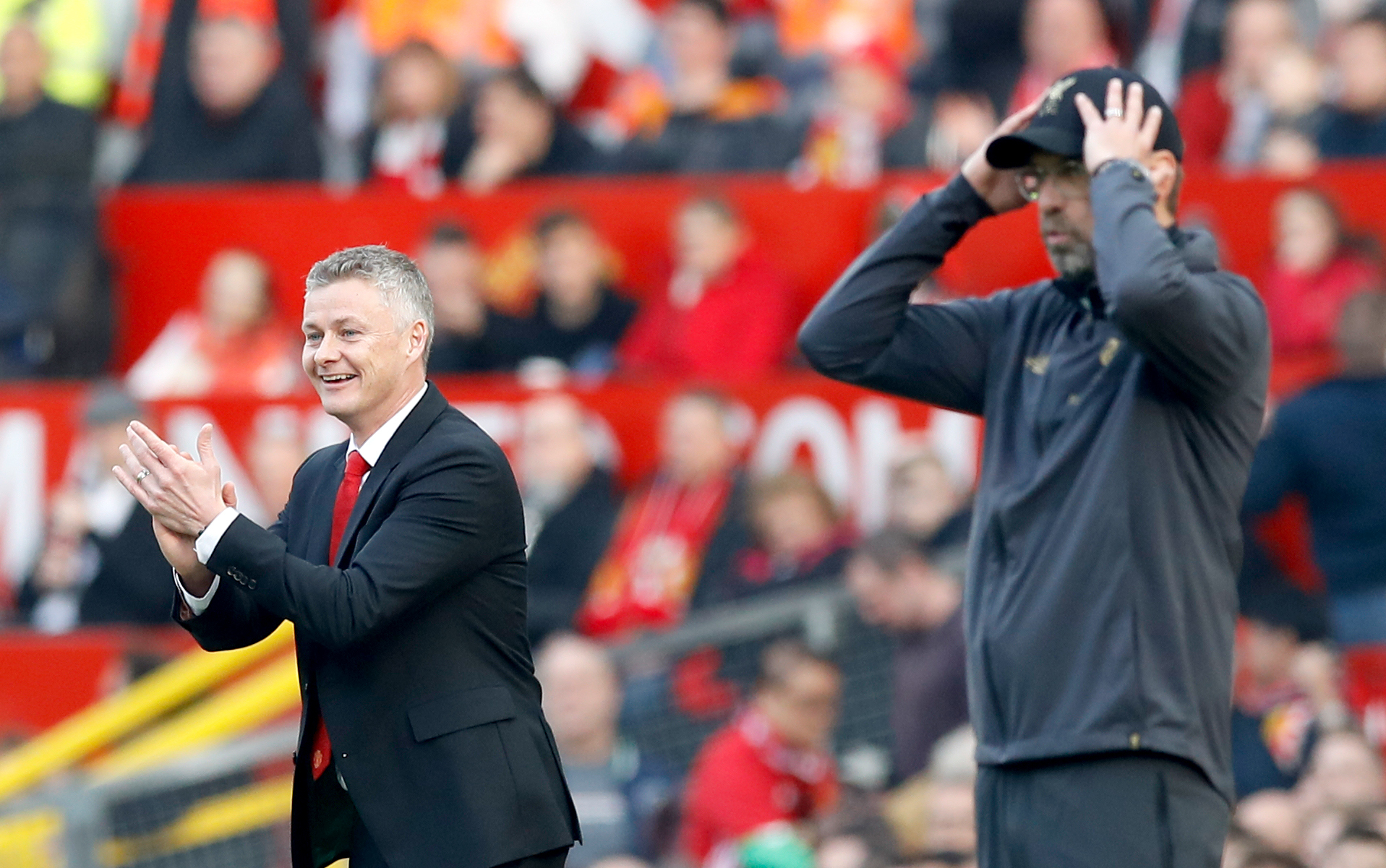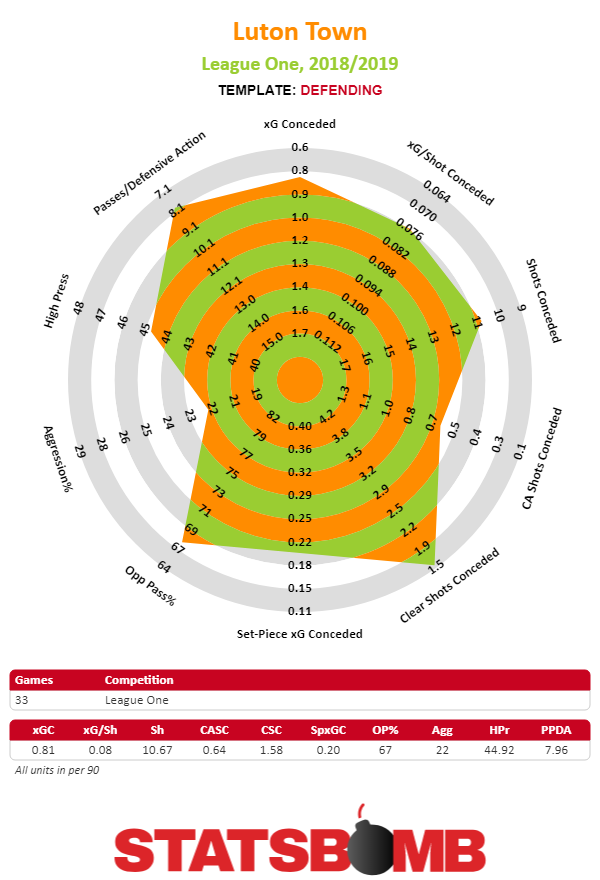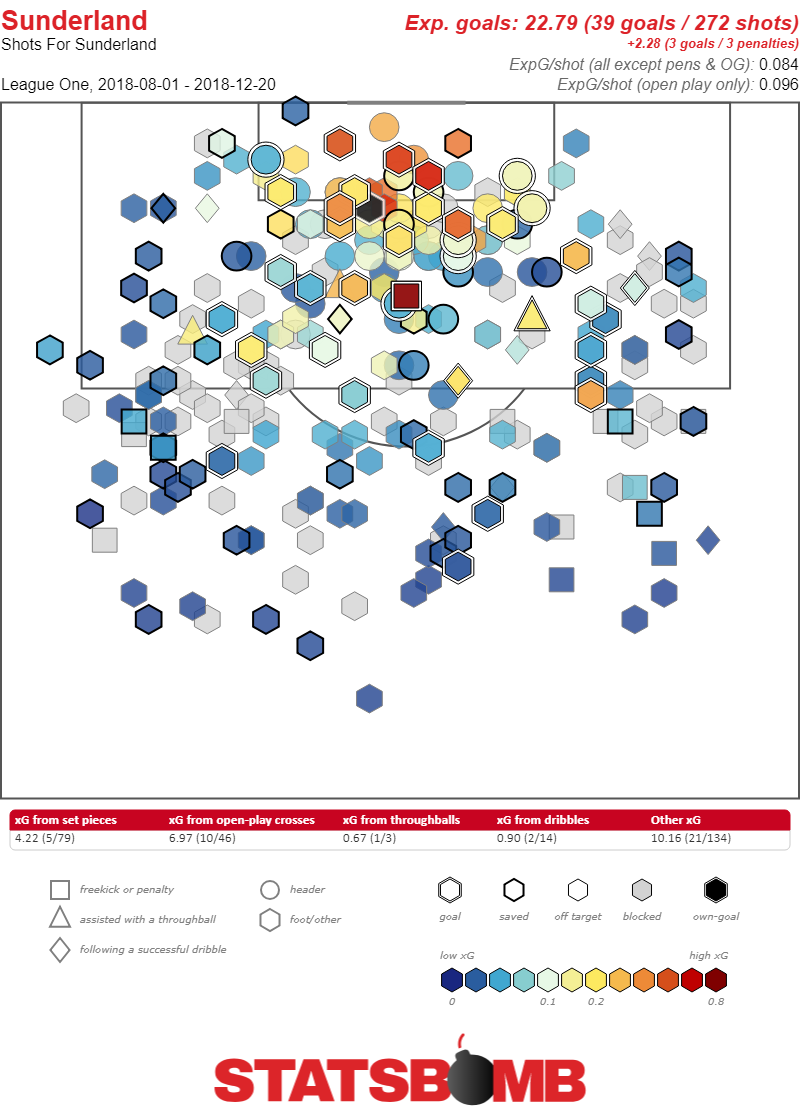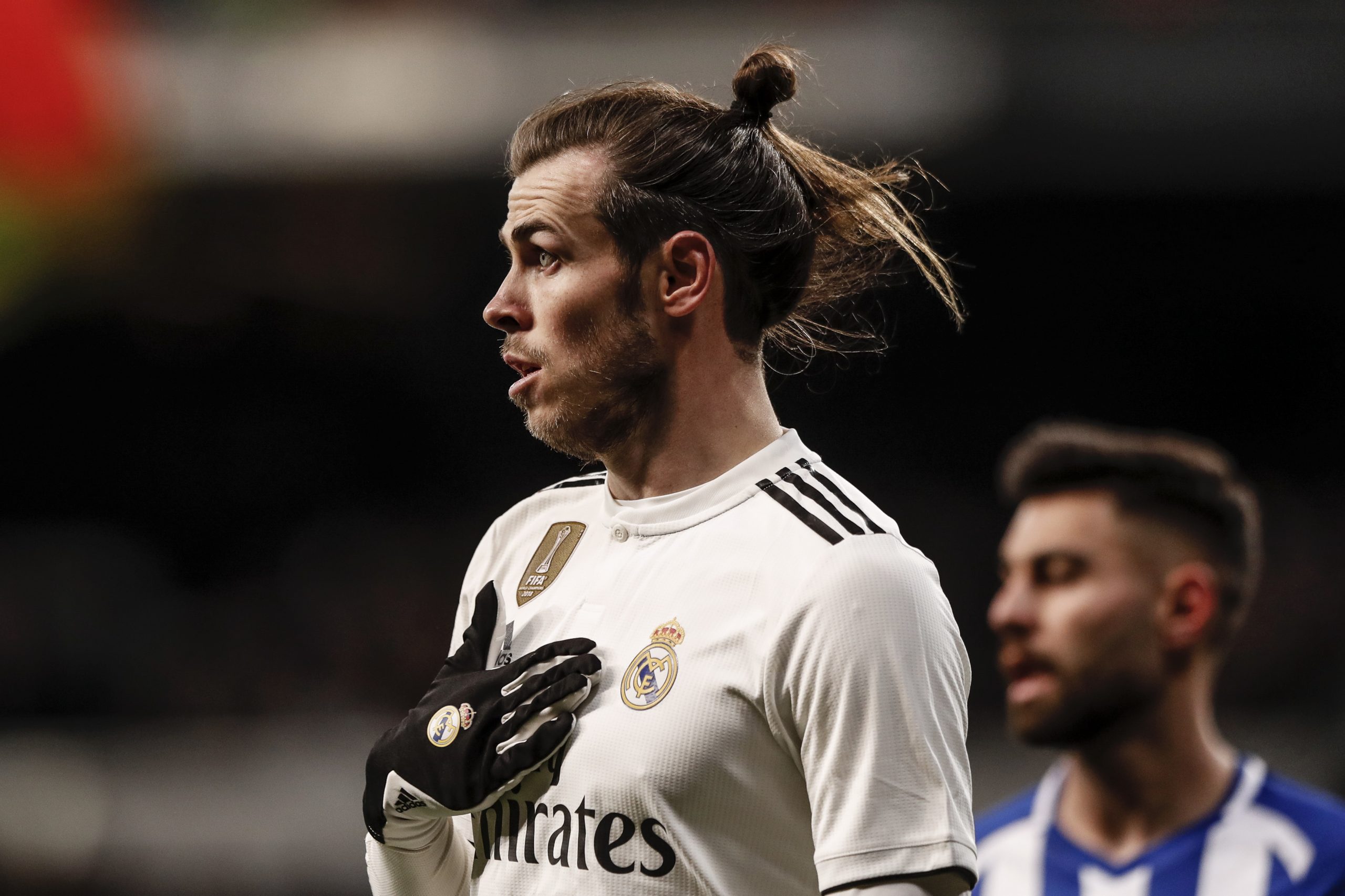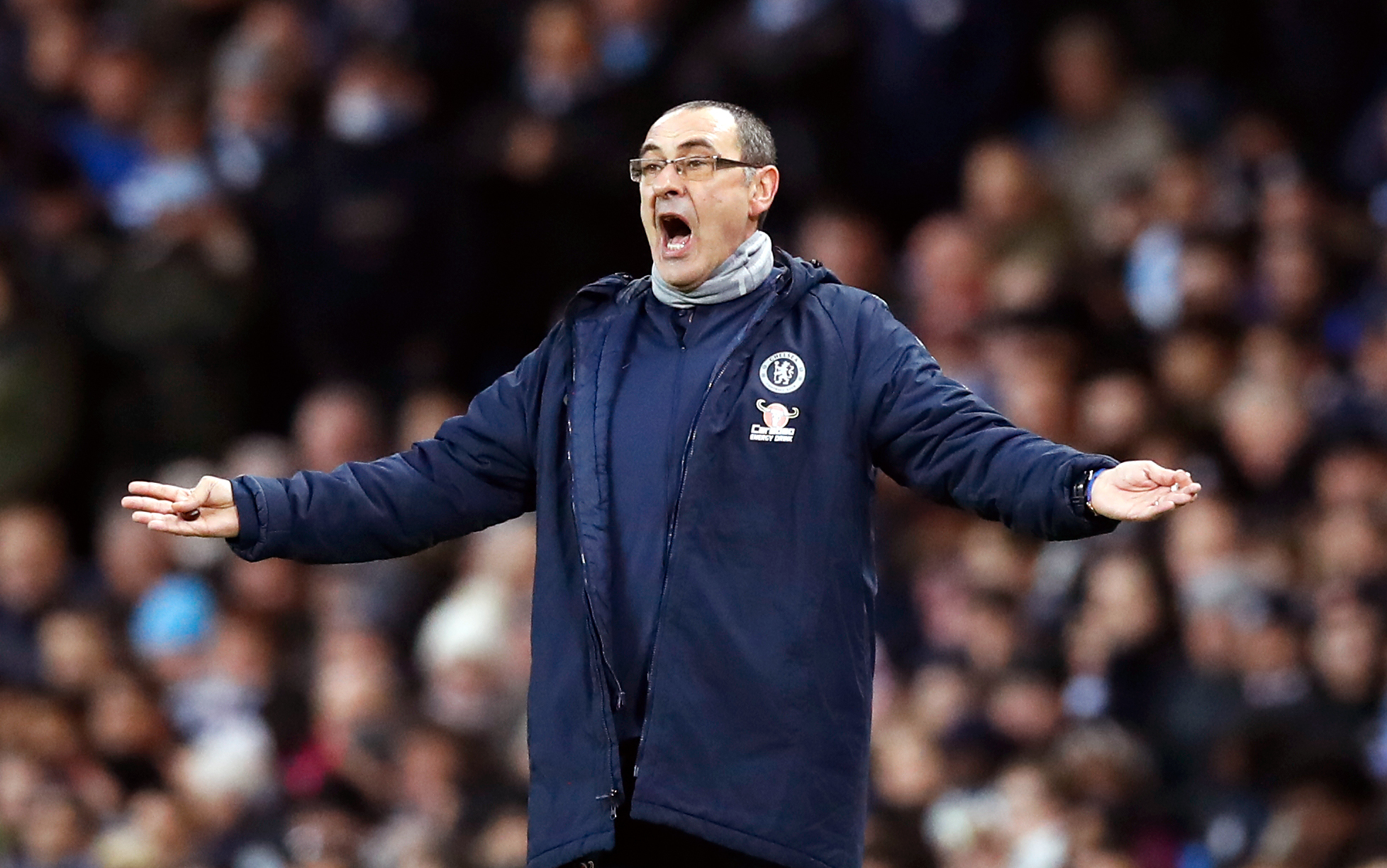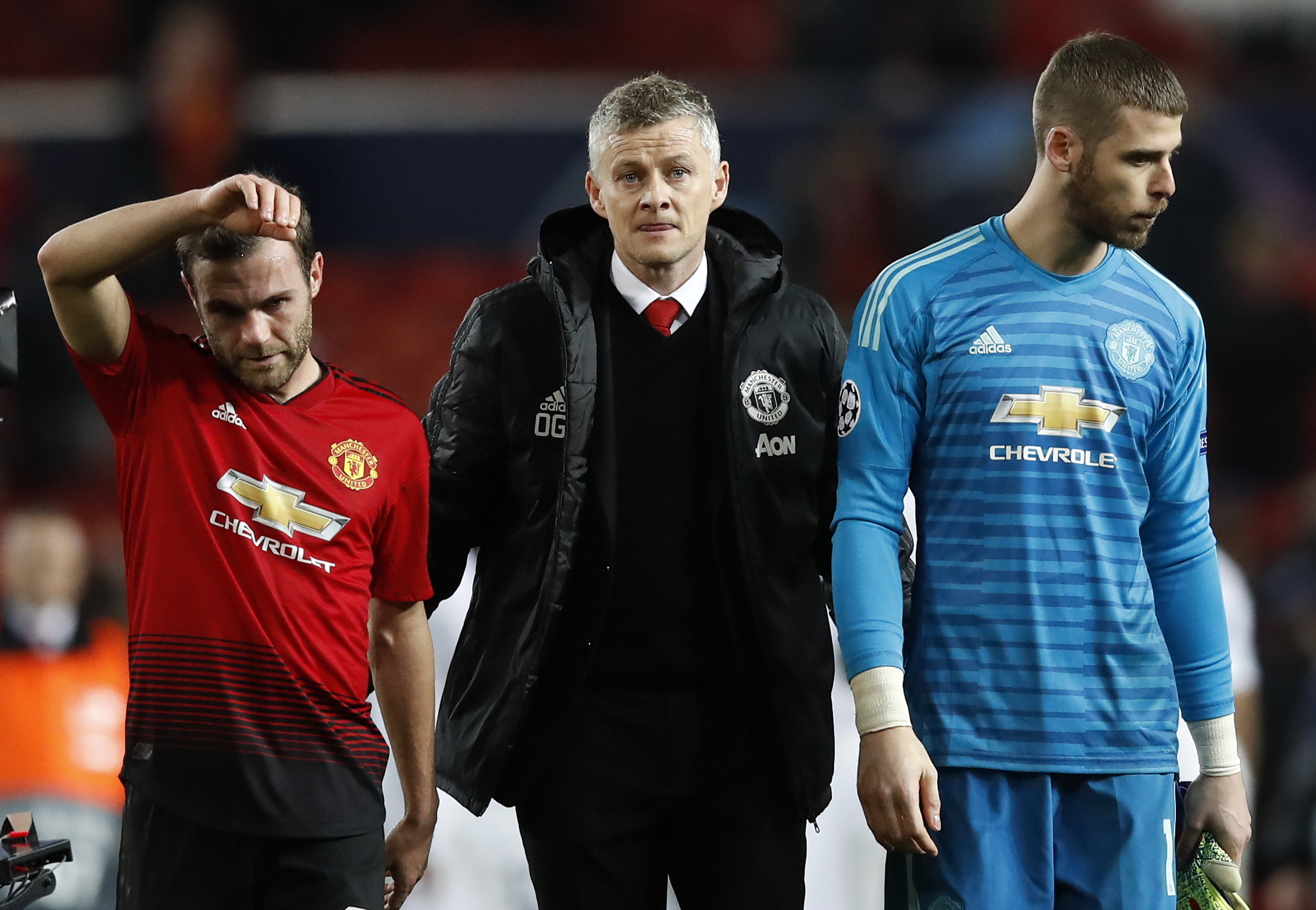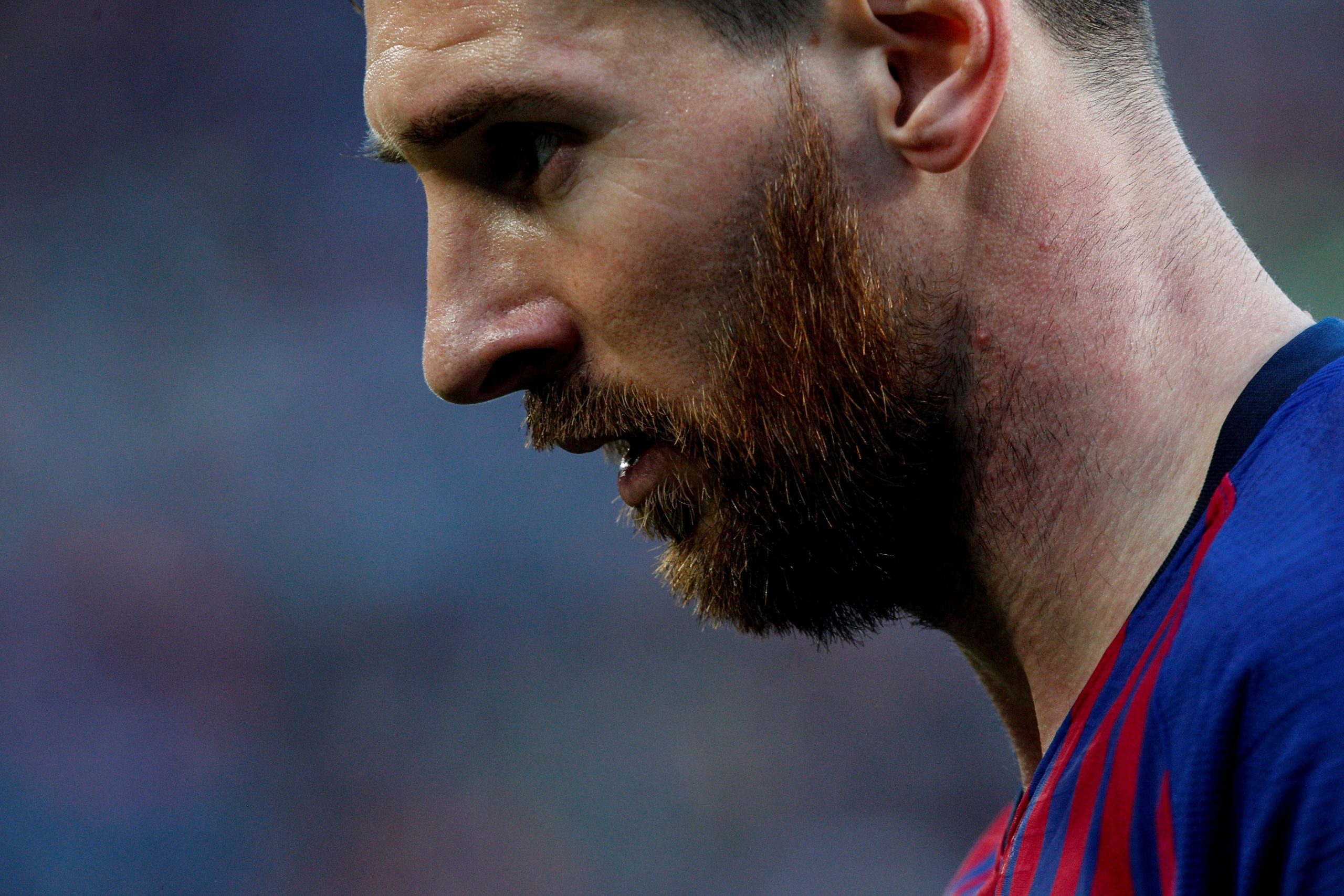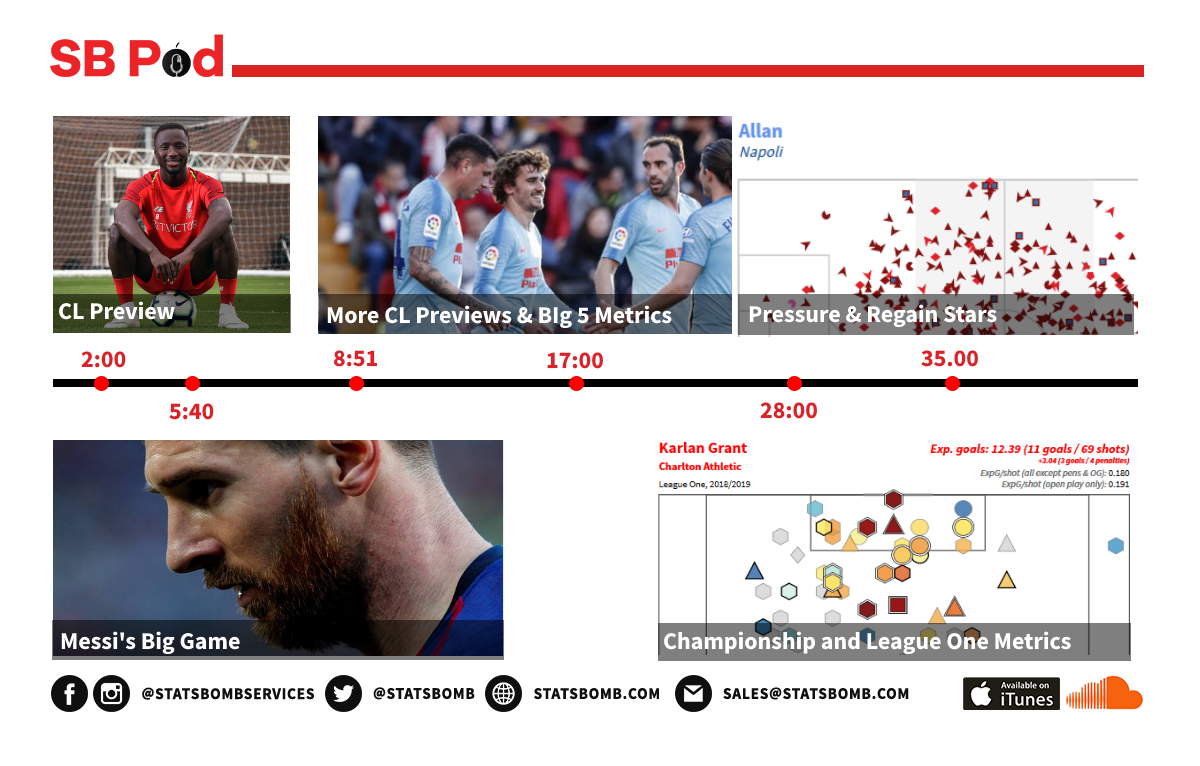Manchester United held Liverpool to a 0-0 draw at Old Trafford last Sunday. It was a surprising result. United’s resurgence has been built more on an improving attack than a stalwart defense and Liverpool are nothing if not explosive in attack. Next comes the tricky proposition of analyzing what it means. By any standard this match was a defensive one. There were only 12 total shots, seven for Liverpool and five for United. The expected goal tally was 0.42 for Liverpool and 0.26 for United. It was truly a slog of a match. 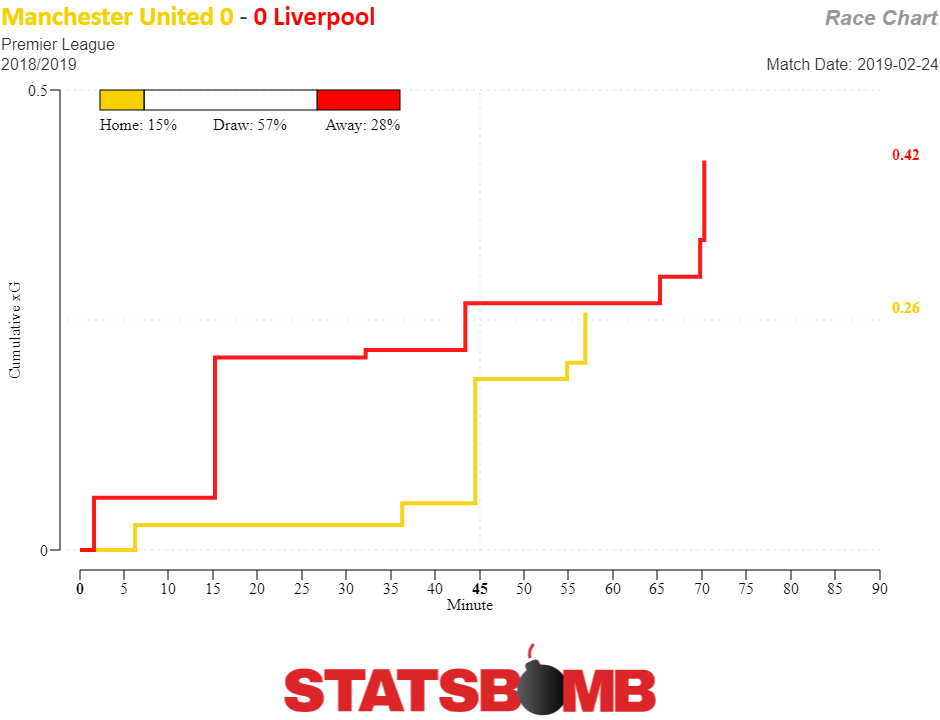 Injuries, of course, play a large story. United were forced into three first half injury substitutions, with Ander Herera, Juan Mata, and Jesse Lingard (Mata’s replacement) all forced off the field. That left the side unable to rescue Marcus Rashford from his own ankle knock. Rashford spent the bulk of the last hour of the match hobbling around at striker unable to contribute much beyond occasional grimacing link up play to United. Liverpool meanwhile lost Roberto Firmino the creative fulcrum around whom Liverpool frequently pivot between their two preferred formations. Taking all those injuries into account, it’s still eye opening that Liverpool was not able to create more against this depleted United side. United’s resurgence has been built on a more open attack featuring which has unleased Paul Pogba and freed players like Rashford, Lingard, and the also injured Anthony Martial to focus on their attacking responsibilities while trusting themselves to score enough to cover for the defense frailties they might leave exposed behind them. And here they are against Liverpool, even a Liverpool side without Firmino, stand firm and conceding nothing. What to make of that? Apportioning credit and assigning blame after a match like this is a bit like one of those logic problems where you have to figure out if a coin is slightly heavier or slightly lighter than the rest of the bunch. Was the story of this match that Liverpool played badly, thus creating the illusion of a strong United defense, or does United really have some surprising steel under the surface which Liverpool unsuspectingly ran headlong into. Or, as it usually is, is the truth somewhere in the middle. There’s also the challenge of negotiating the difference between these two team’s performance in a single match, and what it means for the rest of the season. It’s possible, for example, that United really did put in a spectacular defensive performance, even while still being only a mediocre defensive team. Alternatively, even if all that happened at Old Trafford was that Liverpool played poorly and Mohammed Salah was off his game, that doesn’t mean that Liverpool are destined to all of a sudden become an attacking struggler. Sometimes even the most potent attacks have off days. And, sure enough, soon after the match Liverpool returned to their high-octane attacking ways and thumped Watford at Anfield 5-0. That is, for comparison’s sake, a Watford side that is roughly equivalent to United in terms of expected goals allowed.
Injuries, of course, play a large story. United were forced into three first half injury substitutions, with Ander Herera, Juan Mata, and Jesse Lingard (Mata’s replacement) all forced off the field. That left the side unable to rescue Marcus Rashford from his own ankle knock. Rashford spent the bulk of the last hour of the match hobbling around at striker unable to contribute much beyond occasional grimacing link up play to United. Liverpool meanwhile lost Roberto Firmino the creative fulcrum around whom Liverpool frequently pivot between their two preferred formations. Taking all those injuries into account, it’s still eye opening that Liverpool was not able to create more against this depleted United side. United’s resurgence has been built on a more open attack featuring which has unleased Paul Pogba and freed players like Rashford, Lingard, and the also injured Anthony Martial to focus on their attacking responsibilities while trusting themselves to score enough to cover for the defense frailties they might leave exposed behind them. And here they are against Liverpool, even a Liverpool side without Firmino, stand firm and conceding nothing. What to make of that? Apportioning credit and assigning blame after a match like this is a bit like one of those logic problems where you have to figure out if a coin is slightly heavier or slightly lighter than the rest of the bunch. Was the story of this match that Liverpool played badly, thus creating the illusion of a strong United defense, or does United really have some surprising steel under the surface which Liverpool unsuspectingly ran headlong into. Or, as it usually is, is the truth somewhere in the middle. There’s also the challenge of negotiating the difference between these two team’s performance in a single match, and what it means for the rest of the season. It’s possible, for example, that United really did put in a spectacular defensive performance, even while still being only a mediocre defensive team. Alternatively, even if all that happened at Old Trafford was that Liverpool played poorly and Mohammed Salah was off his game, that doesn’t mean that Liverpool are destined to all of a sudden become an attacking struggler. Sometimes even the most potent attacks have off days. And, sure enough, soon after the match Liverpool returned to their high-octane attacking ways and thumped Watford at Anfield 5-0. That is, for comparison’s sake, a Watford side that is roughly equivalent to United in terms of expected goals allowed. 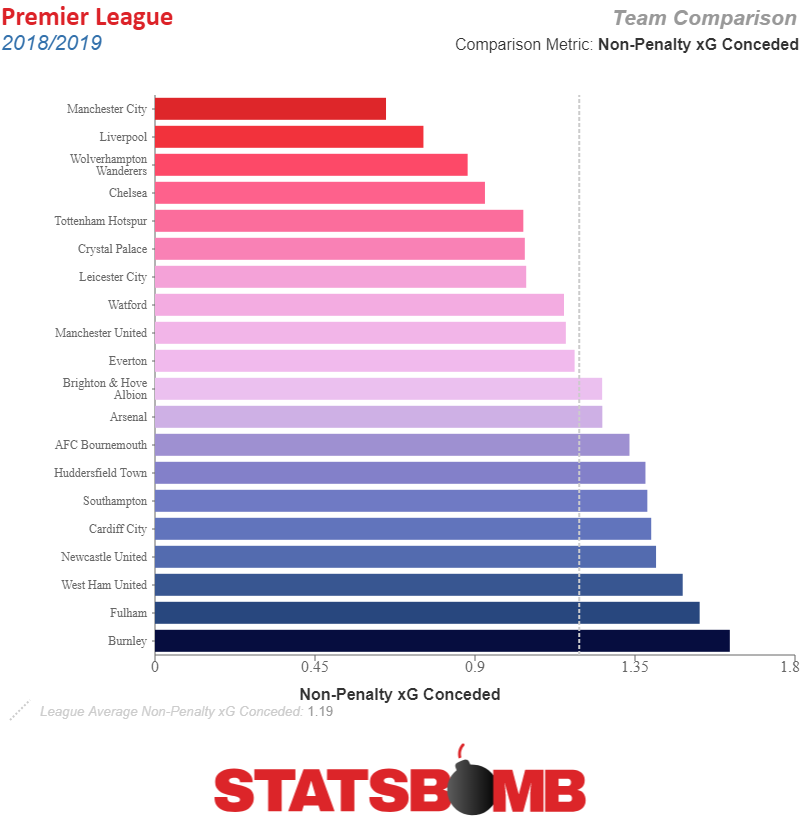 And United also reverted to form, although their form is a little harder to parse. They comfortably handled Crystal Palace, going to Selhurst Park and winning 3-1. They also gave up 17 shots in the process and despite spending most of the game with the result never truly looking in doubt, managed to be unconvincing in defense while also scoring a bunch. The earliest of early returns suggest that whatever happened between Liverpool and United at won’t actually have outsized impact on how the two teams continue to play as the season winds down. Figuring out if the coin was slightly heavier or slightly lighter at Old Trafford is an interesting and worthwhile endeavor for understanding the match, but it’s possible that it’s also one that won’t shed much light on the futures of the two teams involved. Narrowly this makes sense. Liverpool might not have been prepared to deal with losing Firmino in the moment, and his replacement, Daniel Sturridge remained largely invisible after coming on. But, given even half a week to prepare, instead of deploying Sturridge, they shifted Sadio Mane up top and started Divock Origi on the left. Meanwhile, United, outside of the context of being injured beyond belief and trying to defend and survive against a great Liverpool side, went back to their swashbuckling, if slightly vulnerable ways. Broadly this makes sense too. The search to find meaning in the Premier League’s marquee matchups is understandable but often flawed. The biggest matches of the season are often defined by two teams wrestling imperfectly to stamp their influence on a match. Results are frequently defined by which teams gets to play their preferred strategy and which team is forced to adjust. Who wins those encounters matters to an outsized degree, because in a closely contested league, every point counts, giving added importance to those moments when a squad gets to both gather points for themselves while also denying their rivals an opportunity to do the same. But, at the same time, those matches are often not the best indicators of how good a team is. The individual factors at play in an individual match between two heavyweights are often outweighed over the course of a season by how teams play against everybody else. Liverpool’s attack is great because it brings the pain week in and week out. The stutter against United isn’t bad luck, but it’s also not more important than everything else we’ve seen. The same is true of United’s defense. The concerns remain despite the performance against Liverpool. Any time Liverpool go to Old Trafford it’s a massive match. The points won and lost will frequently be consequential in the standings at the lofty end of the table. It’s important to understand why and how those games end the way they do. It’s also important to understand the limits of what they can tell us about the two teams competing in those matches. Header image courtesy of the Press Association
And United also reverted to form, although their form is a little harder to parse. They comfortably handled Crystal Palace, going to Selhurst Park and winning 3-1. They also gave up 17 shots in the process and despite spending most of the game with the result never truly looking in doubt, managed to be unconvincing in defense while also scoring a bunch. The earliest of early returns suggest that whatever happened between Liverpool and United at won’t actually have outsized impact on how the two teams continue to play as the season winds down. Figuring out if the coin was slightly heavier or slightly lighter at Old Trafford is an interesting and worthwhile endeavor for understanding the match, but it’s possible that it’s also one that won’t shed much light on the futures of the two teams involved. Narrowly this makes sense. Liverpool might not have been prepared to deal with losing Firmino in the moment, and his replacement, Daniel Sturridge remained largely invisible after coming on. But, given even half a week to prepare, instead of deploying Sturridge, they shifted Sadio Mane up top and started Divock Origi on the left. Meanwhile, United, outside of the context of being injured beyond belief and trying to defend and survive against a great Liverpool side, went back to their swashbuckling, if slightly vulnerable ways. Broadly this makes sense too. The search to find meaning in the Premier League’s marquee matchups is understandable but often flawed. The biggest matches of the season are often defined by two teams wrestling imperfectly to stamp their influence on a match. Results are frequently defined by which teams gets to play their preferred strategy and which team is forced to adjust. Who wins those encounters matters to an outsized degree, because in a closely contested league, every point counts, giving added importance to those moments when a squad gets to both gather points for themselves while also denying their rivals an opportunity to do the same. But, at the same time, those matches are often not the best indicators of how good a team is. The individual factors at play in an individual match between two heavyweights are often outweighed over the course of a season by how teams play against everybody else. Liverpool’s attack is great because it brings the pain week in and week out. The stutter against United isn’t bad luck, but it’s also not more important than everything else we’ve seen. The same is true of United’s defense. The concerns remain despite the performance against Liverpool. Any time Liverpool go to Old Trafford it’s a massive match. The points won and lost will frequently be consequential in the standings at the lofty end of the table. It’s important to understand why and how those games end the way they do. It’s also important to understand the limits of what they can tell us about the two teams competing in those matches. Header image courtesy of the Press Association
Month: February 2019
League One Review: The Championship Awaits, But For Who?
Not a season goes by without the words “Premier League” and “Best League In The World” being uttered in the same sentence.
The statement does, of course, have some merit and, in terms of the quality of playing and management personnel, it’s probably true. However, look below it and you’ll find stalwarts of the EFL leagues who know that it’s rarely the most entertaining nor even the most competitive league in England, let alone the rest of the world.
This season, League One has made a strong claim to be the most compelling with a heated title and automatic promotion race and a relegation battle that at the time of writing involves pretty much the entire bottom half with just a third of the season remaining.
At the summit, there’s three places up for grabs in next season’s Championship table and as we now enter the home straight, it’s the perfect time to put the Championship elect under the microscope and see what they’re doing right – or wrong – in their attempts to ascend into the second tier.
Doncaster:
If the season started from scratch, Doncaster would be much more favoured for a top two finish than they currently are now.
Thanks to a run of poor form pre-Christmas, Donny fell out of the top six but a recent revival has seen them angle their way back in and it’d be a major surprise if they were to fall away now. Their expected goal difference of 0.41 goals per game across the season is actually the fourth best in the league up to now and comfortably so. Doncaster will be a force in the playoffs and could even be the team to fear going into them with their press looking more restrictive than ever.
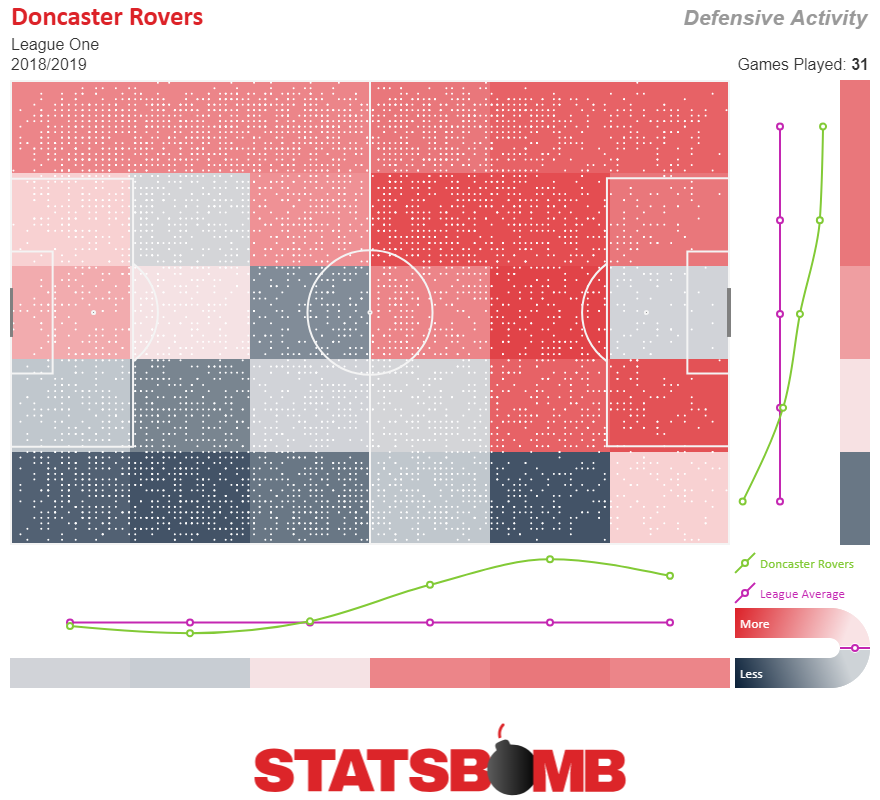
Developing the press has been a process and in fact defensive solidity has, up until recently, been Doncaster’s weakness – they’ve kept just eight clean sheets all season. Their expected goals conceded has been gradually trending downward however, a sign that the team could be starting to play to their full potential with manager Grant McCann still only in the job for eight months.
Given their early defensive struggles, it sure helped to have a striker who’s one of the best around at this level. In John Marquis they have a forward who’s comfortably the team’s biggest goal threat, but who also creates chances for others and even defends from the front as well.
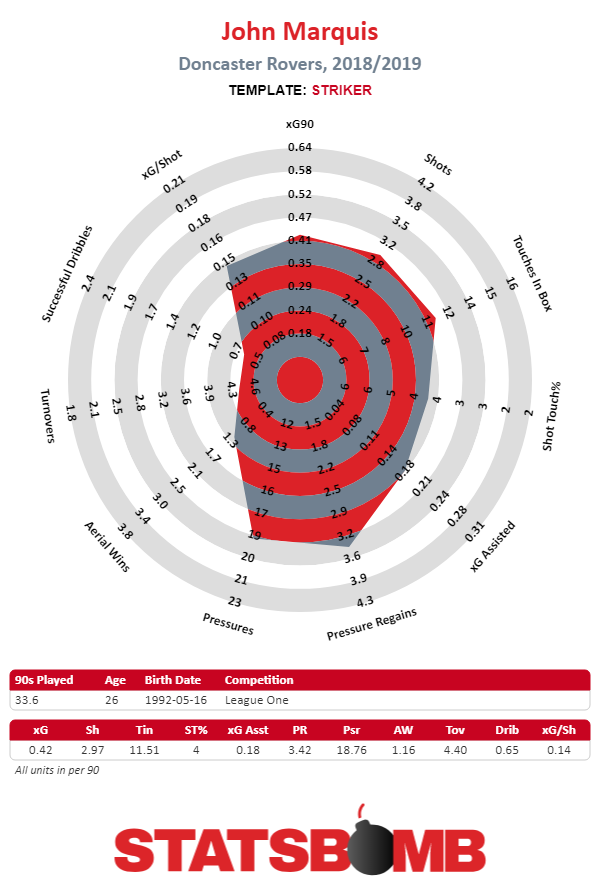
Charlton:
Currently in 5th you have Charlton. In context, they’ve had a very impressive season so far after a cruel run of medium-term injuries to key players meant several academy players had to start games and there’s even been occasions where they’ve been unable to name a full subs bench.
Sadly though, their valiant run could be tailing off just as their injury problems ease. The break up of their 26-goal forward duo seems to be the main cause as Karlan Grant left strike partner Lyle Taylor and departed for the Premier League, sealing a cheap-looking £2million January move to Huddersfield.
A recent three game spell immediately after Grant had left the club and whilst Taylor was serving a suspension highlighted the lack of depth Charlton have up front, with the team now looking overly reliant on Taylor to carry the goal burden he previously shared with Grant.
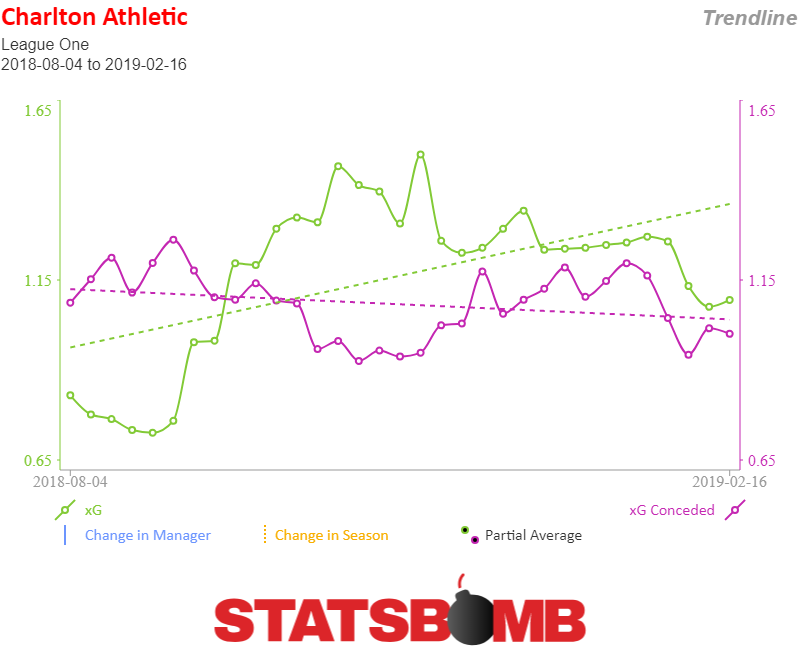
Charlton were already wringing every last point from their 0.14 expected goal difference per game, just about enough to put them in the “playoff contender” category in underlying numbers terms, but with Grant not being adequately replaced - Josh Parker arrived from relegation candidates Gillingham on a short-term deal - it’s fair to say Charlton won’t be the favourites heading into the playoffs if they hold onto their top six place.
Portsmouth:
At one stage, Portsmouth were comfortably champions elect after a stratospheric W14 D5 L1 record to open the season that took them six points clear at the top.
Portsmouth did (and do) actually have positive underlying numbers though and whilst a points return of that scale was always unlikely to be sustained, the drop off in the 14 games since has been unsettling for the neutral and outright horrifying for the fans, picking up just 15 points in that spell.
Having conceded just 15 goals in their hot start, goalkeeper Craig MacGillivray played a big part in their push to the top of the table. StatsBomb’s post-shot expected goals model believes he saved close to five goals more than Portsmouth were expected to concede from the shots their opponents were taking.
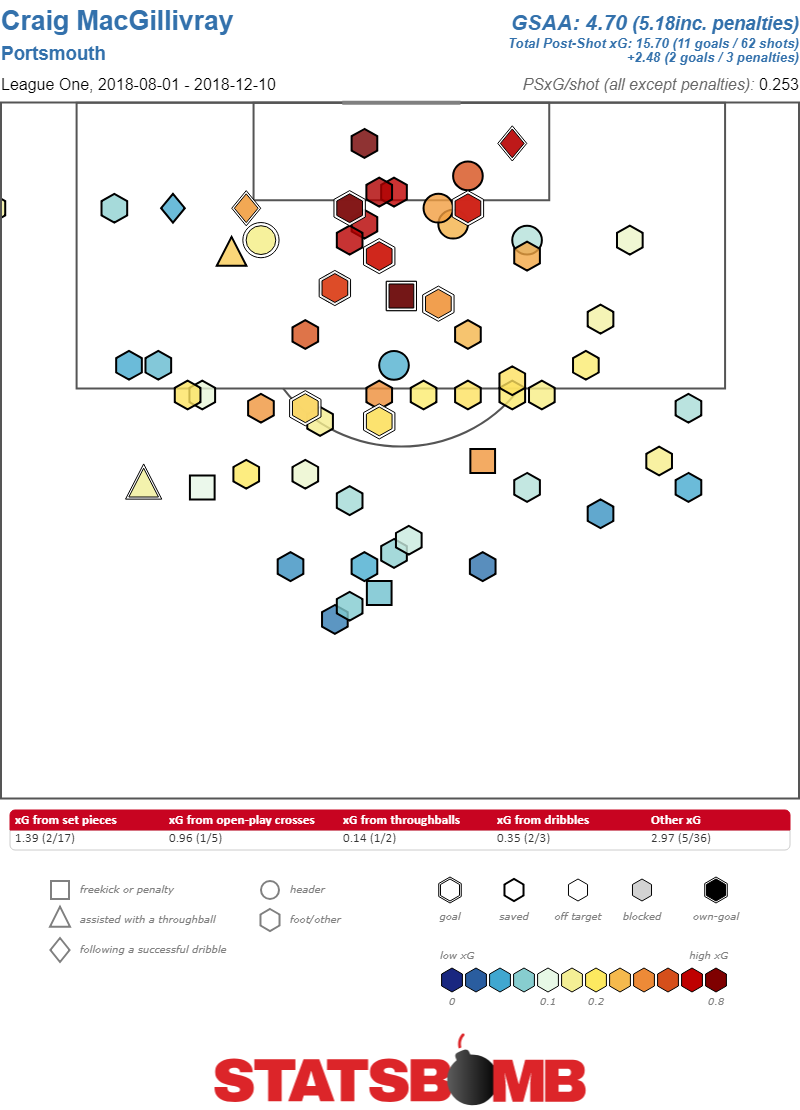
Unfortunately, he couldn’t sustain that form. In the 14 games where Portsmouth’s results have been more akin to that of a relegation struggler, MacGillivray has also been struggling and has now been saving below expectation.
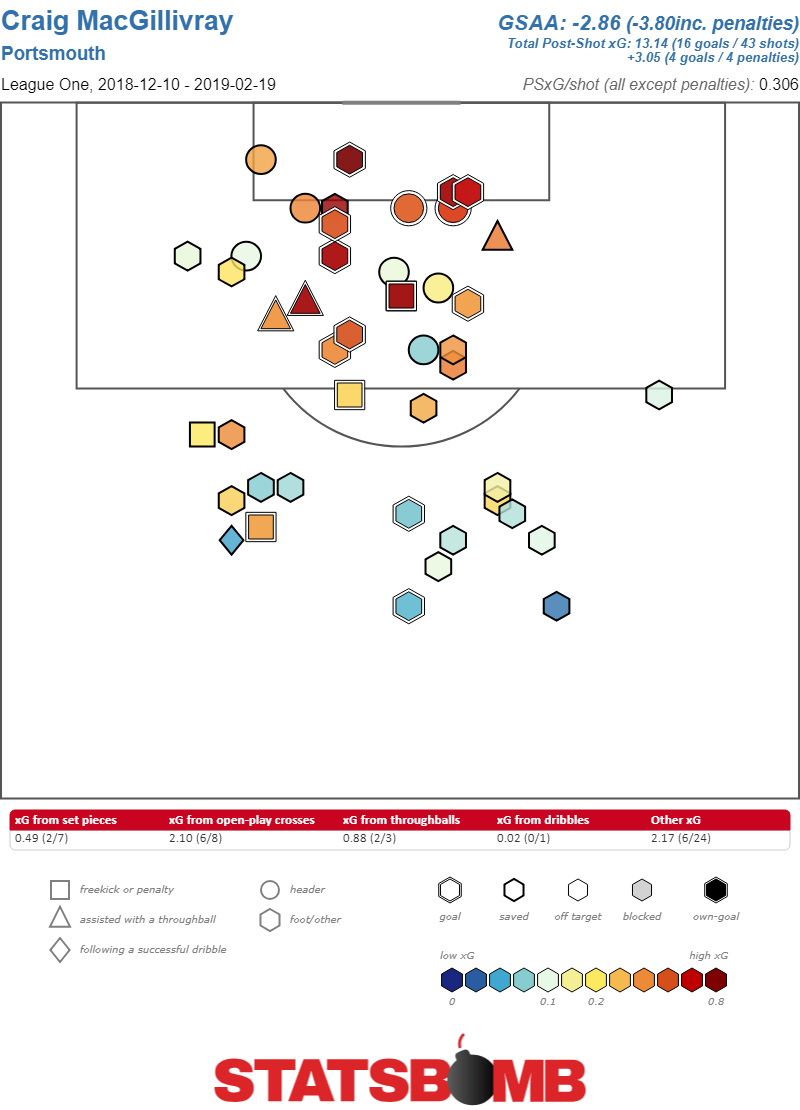
Of course, it’s not all MacGillivray’s fault and in recent games there’s been a clearly visible decline in Portsmouth’s attacking output too.
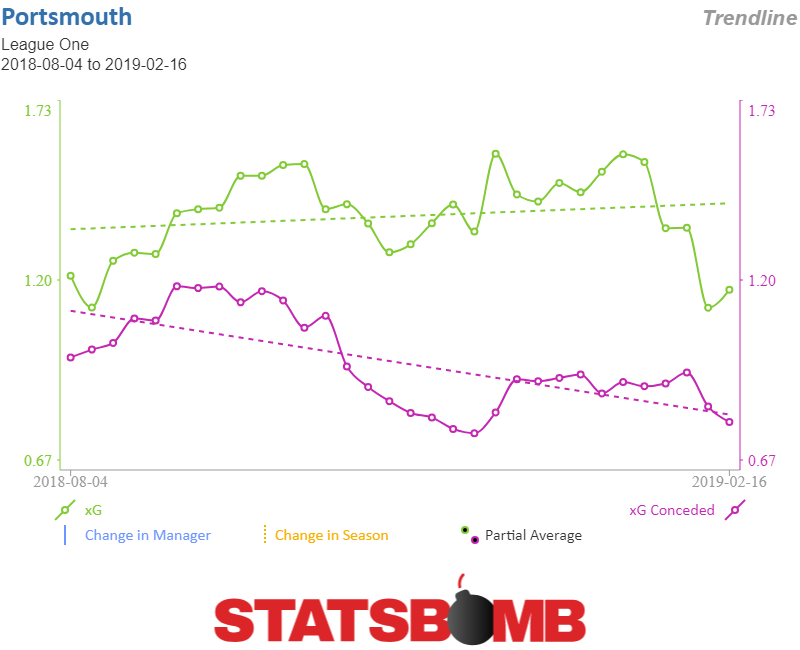
With the top two looking increasingly out of reach, Portsmouth need to get their act together if they’re to recover their early season form and remain a serious contender for promotion.
Sunderland:
Recently of Match of the Day fame but nowadays seen on Netflix, Sunderland initially took very well to League One and they have some impressive performance indicators to back it up. The team has lost just two games so far and are also the only team to have scored in every single league game this season.
Trouble is, there are also some performance indicators that aren’t as impressive.
In the first 20 games of the season, Sunderland wildly overperformed their expected goals in attack, scoring at nearly double the rate they were expected to. While that made fans understandably chipper about their prospects of an instant return to the second tier, it also foreshadowed the problems that followed.
Since then, the Black Cats luck ran out, and they were recently on a barmy run of scoring exactly one goal in ten consecutive league games, a run that included six 1-1 draws and was only ended by a 2-2 draw.
As you can see below, performances haven’t necessarily gotten worse, it’s just that they’ve started scoring to expectation.
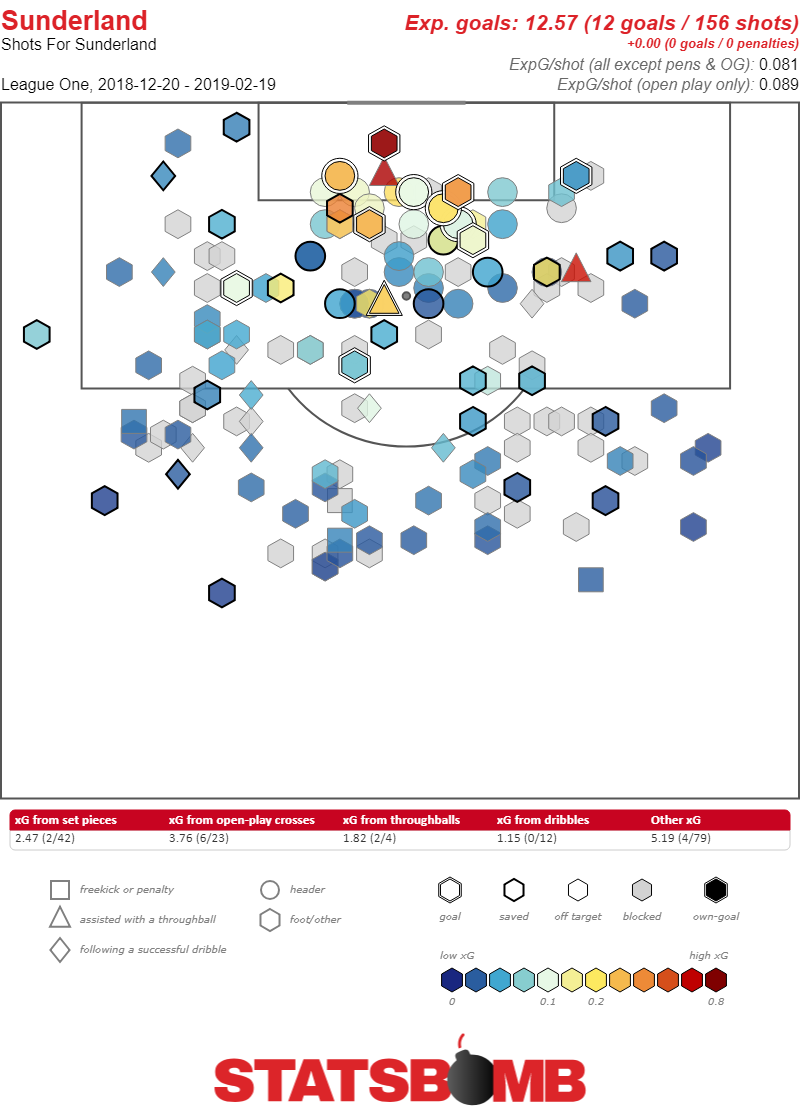
In truth, Sunderland hadn’t been playing like a side capable of automatic promotion all season but their last four games have all of a sudden seen them create a lot more chances than we’ve seen from them previously, ironically seeing them fail to get wins that they probably deserved.
For now, the Black Cats claws cling onto Barnsley’s coat tails. Who knows, maybe these shot maps will make it into Sunderland Till I Die Season Two...
Barnsley:
Occupying the first of two automatic promotion places, Barnsley look well set to return to the Championship at the first attempt. New boss Daniel Stendel has impressed since being imported from Germany, successfully implementing the counter-pressing style of play he promised when appointed.
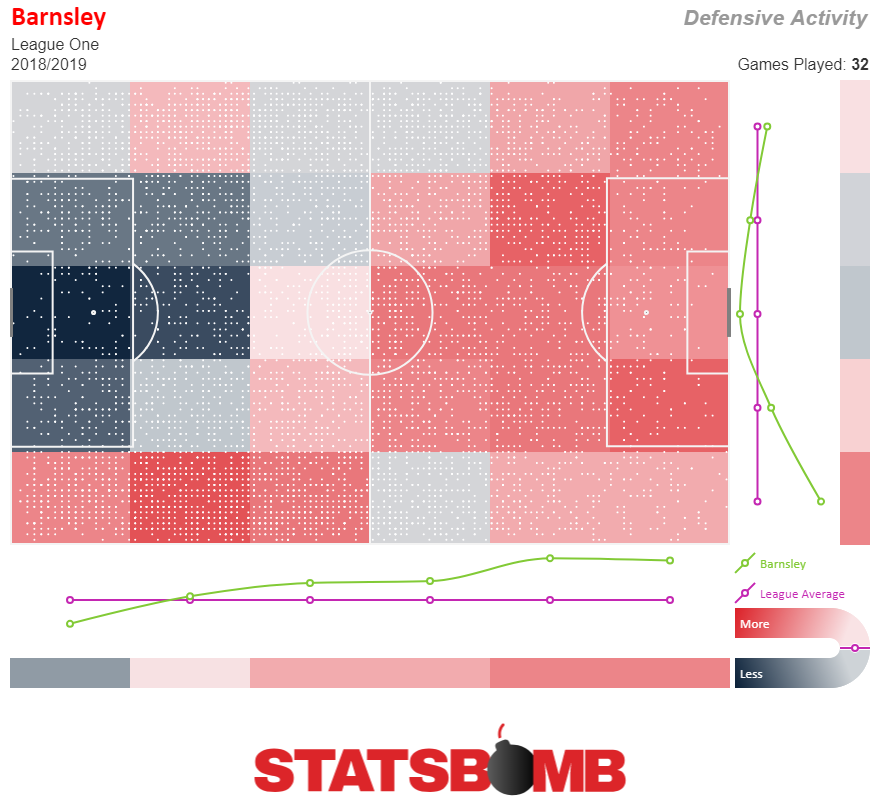
To great effect too. By StatsBomb’s numbers, Barnsley are actually the best side in the league by expected goal difference and their brief stint outside of the play off places was followed up by a return of 31 points from the next 39 available.
And all this without an experienced head. Someone who’s been there and done that. This is a side that hasn’t given a single minute of football to a player over 26 years of age this campaign.
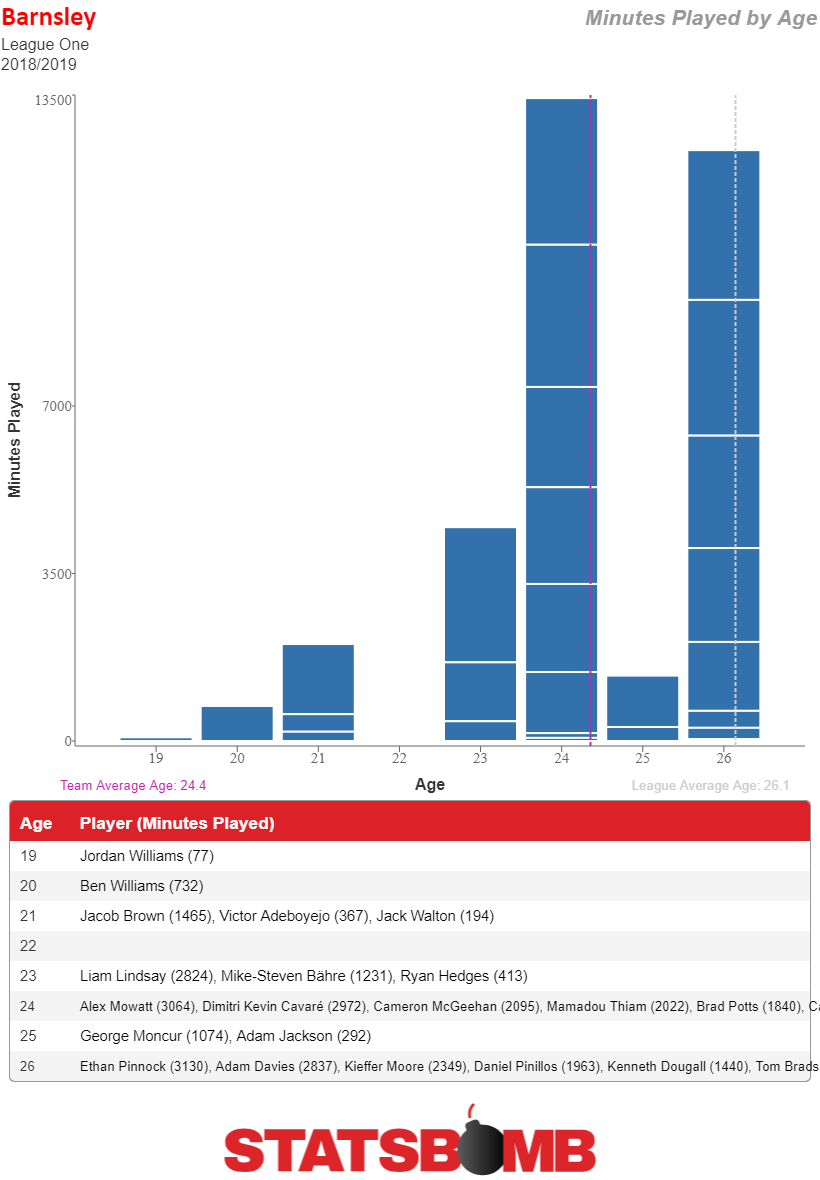
Some may call it a smart strategy given what we know about the peak performance window in footballers, others may call it blatant ageism.
That’s a fight for another day. Barnsley find themselves in 2nd place and one of three remaining realistic title contenders. Luton have a not-insignificant points advantage over their rivals, but Barnsley’s top performance appears to be of a higher level than Luton’s based on the underlying numbers. So what do Barnsley have to overcome in the home straight?
Luton:
After a slightly tentative start to the season, Luton all of a sudden caught fire and have been a juggernaut ever since, knocking aside anyone who’s dared step into their path.
Their approach play has received a lot of praise this season – they are top scorers after all - but defensively they’ve been equally, if not more, impressive and they’ve conceded the joint-2nd fewest goals and, again bar one team, have kept the most clean sheets too.
Their underlying numbers support this. By expected goals, Luton have the most solid defence in the league with just 0.81 xG conceded per game. Look at their defensive radar and you can gain a greater understanding of why that figure is so low.
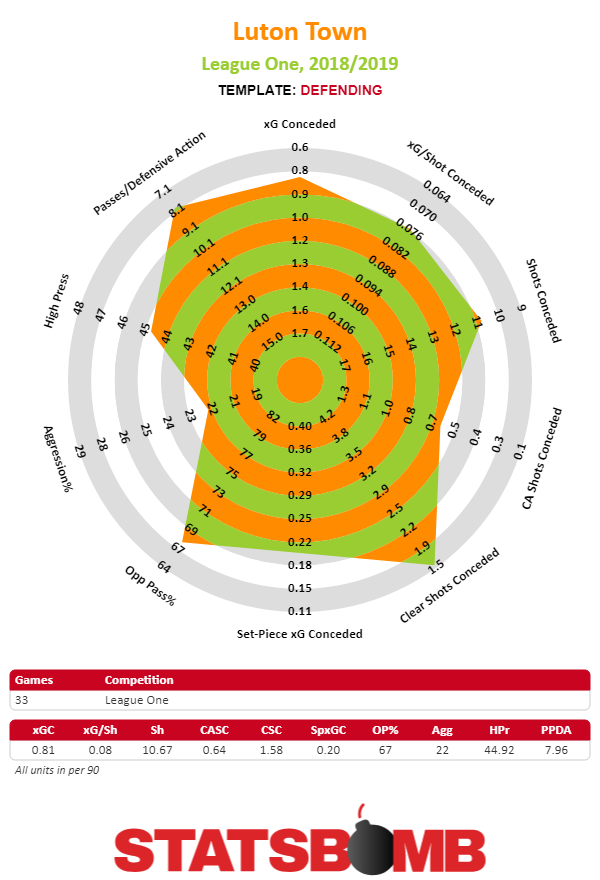
Luton are just very difficult to create against. They rank 2nd in Shots Conceded per game but their xG per shot conceded is also 3rd best in the league, meaning not only are they great at limiting the quantity of shooting opportunities created against them, they’re successfully limiting the quality of those opportunities too.
Another plus point is that whenever Luton have had an injury or suspension, the player coming into the side hasn’t hindered the quality of the side at all.
Scoring Contribution is a metric that measures non-penalty goals + assists, per 90 minutes played. Here’s how Luton’s players rank this season.
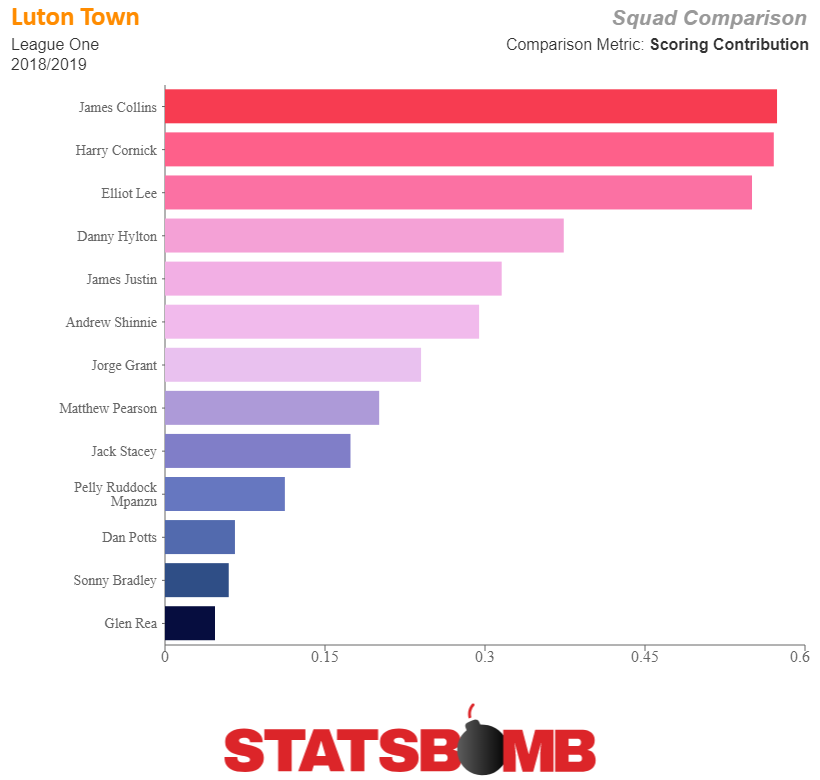
James Collins has been the only constant this season but the other attackers, Harry Cornick, Elliot Lee and Danny Hylton, have all had extended spells out of the side. As you can see, the output of all three has been very similar and the graph doesn’t even include Kazenga LuaLua (0.73 NPGoals + Assists per 90) as he doesn’t meet the minimum 600 minutes played threshold. Remove one of Luton’s limbs and they’ll just grow another one right before your eyes.
It’s Luton’s title to lose, but seemingly just two names remain on the list of challengers.
Replacing a Superstar: How Spurs (Eventually) Moved on From Gareth Bale
How do you replace a superstar footballer? Stars, by their very nature, are hard to replace; that’s why they’re stars. At any moment, there’s only a handful of Ballon d’Or-caliber players out there. Only some of them have their best years ahead of them. Even at a young age, these players tend to cluster at the world’s richest clubs. Only a subset of those clubs can afford to buy a superstar. Every time such a transaction occurs, the selling club must try to replace someone whose value stemmed from the absence of any comparable alternatives. This remains unfamiliar territory. The blockbuster transfer of a superstar, even in this era of TV deals and rising fees, remains a rarity. Good players are bought and sold in every window, but the transfer record has only been set seven times in this millenium. (The nominal fee for Hernan Crespo, the millennium's first record-setter, is about what Manchester City paid for Benjamin Mendy.) It’s still unusual for a club to lose a singular player and bring in the kind of money that allows for meaningful squad reconstruction. Spare a thought, then, for Tottenham Hotspur in the summer of 2013. The club had just sold Gareth Bale for a then-record €100.8 million. He really was that good, the closest thing to a one-man team and just entering his prime. Now what? In short, Spurs turned their Bale money and some spare cash into seven new signings, none of whom cost more than 30 percent of the Bale fee. Since nobody remembers what nine-figure fees meant in 2013, it’s helpful to think of what comparable fees netted in the Premier League that summer. Let’s remember some guys:
- Roberto Soldado and Erik Lamela, the two biggest purchases, each cost a bit less than Marouane Fellaini and a few million more than Stevan Jovetic and Alvaro Negredo.
- Paulinho’s transfer fee ranked between those paid by Chelsea for André Schurrle and Southampton for Dani Osvaldo.
- Christian Eriksen basically cost Spurs as much as Cardiff City spent on Gary Medel.
- Étienne Capoue’s acquisition was equivalent to Simon Mignolet’s move to Liverpool.
- Vlad Chriches cost Spurs about £500,000 more than Cardiff paid them for fellow center back Steven Caulker. His fee was tantamount to what Southampton spent on Dejan Lovren and Norwich spent on Ricky van Wolfswinkel.
- Nacer Chadli’s price matched what Liverpool spent on each of Tiago Ilori and Iago Aspas and Aston Villa spent on *squints at notes* Libor Kozák.
Nearly six years later, as various mega-clubs look set for serious rebuilds, it’s worth revisiting the strategies implicit in that list of names. Some of Spurs’ signings may have faded from memory or become less interesting, but their stories can help us better understand the value of capital-s Stars and the challenges of replacing them. /// Spurs immediately conceded that no available player could match Bale’s production (26 goals and 15 assists in 2012-13). The club sought to spread the responsibility between a nominal replacement (Lamela) and upgrades at other positions. Clubs often tell the press — or themselves — a version of this argument when replacing a crucial player. Spurs had tried it the year before, replacing Luka Modric and Rafael van der Vaart with the likes of Hugo Lloris, Mousa Dembélé, Jan Vertonghen, Gylfi Sigurdsson, Clint Dempsey, and Emmanuel Adebayor. Bale ironically became part of a similar argument last summer, when Real Madrid claimed its squad could replace Cristiano Ronaldo’s production. Players like 2013-vintage Gareth Bale are useful in large part because they concentrate so much production in one position. The remaining ten outfield players still contributed but they benefited from the attention paid to their star teammate. Jermain Defoe’s 2012-13 tally of 15 goals was useful to a team with Gareth Bale, but would be insufficient without him. For a team that had given more than 2,000 minutes to each of Aaron Lennon, Dempsey, Michael Dawson, Sigurdsson, Adebayor, Sandro, and Scott Parker in Bale’s final season, versions of this predicament existed at most outfield positions. Signing a superstar is expensive, but upgrading multiple positions to replace the lost production isn’t exactly cheap. Discussing players’ records in absolute terms obscured the cost of replacing all this production. Roberto Soldado arrived in London talking about scoring 20 goals. The number sounded impressive: 20 goals is a lot more than none and a lot more than what you or I could score. It is not, however, that much more than Defoe’s 15. A five-goal upgrade at striker was not going to make up for the very serious downgrade at Bale’s winger-ish position. What really mattered was the new signings production relative to the players they displaced. A club like Tottenham can buy a 10 goal player. Buying a ten-more-goals player is much harder — and Spurs needed more than one such player. It’s worth considering something approaching the best-case scenario for this strategy: Lamela contributes half of what Bale did, Soldado scores 20 goals, every signing starts and improves on an incumbent, nobody regresses. Forget for a second that most of these things did not happen. What reason was there to believe that buying two players from the part of the transfer market where title-chasing clubs purchased marginal starters and a handful of squad players would do the trick? This was akin to fielding Manchester City’s weakened team for cup ties for and expecting to compete for fourth. The players were not unusual flops. With the possible exception of Chiriches, who cost as much as Dejan Lovren (but also Ricky van Wolfswinkel), all of these signings performed about as well as comparable ones made by other clubs. They were improvements on an unimpressive squad, but that’s not all Spurs had hoped for. The strategy of spreading out production, as implemented by Spurs, could only have worked if multiple players improved in unexpected and unusual ways. In that respect, it was less of a strategy than it was an act of faith. Since the summer of 2013, teams have tended to follow the sale of a superstar with their own near-record purchases. Juventus spent the bulk of its Paul Pogba money on the bulk that is Gonzalo Higuain. Barcelona spent most of its Neymar money on Ousmane Dembélé and Coutinho. Those three replacements rank among the ten most expensive transfers in footballing history. Liverpool, in turn, spent the bulk of its Coutinho money on Virgil Van Dijk, who is also on that list. (These clubs were all richer than Spurs and had more talented squads when making these purchases.) Teams with policies of only buying young prospects have stuck to their guns, as Monaco and Borussia Dortmund did after selling Kylian Mbappé and Dembélé, respectively. Otherwise clubs have behaved as if buying one or two really good players — even if they’re at different positions — can better replace an outgoing superstar than a bevy of marginal upgrades. /// Time is rarely kind to transfers. The reality of a player — even a good one — can struggle to live up to the anticipation and techno-scored highlight clips that presaged their signing. Players age, get injured, and suddenly it’s easy to question the process that led to their acquisition. Tottenham’s post-Bale spending spree, on the other hand, has benefitted from the passage of time. What looked like a disaster in 2013 and 2014 has developed redeeming qualities. It might even be good. Christian Eriksen is the most obvious point in favour of that transfer window. Eriksen’s goodness is the least contentious part of this argument so it needn’t be belaboured. You can read StatsBomb supremo Ted Knutson’s praise of Eriksen from his first season with Spurs, which he recently told me “was SO LONG ago.” He’s still good, by the way: he leads the team in xG assisted per 90 minutes while also doing lots of central midfielder work like progressing the ball from deep and pressuring opponents. Once again, he was purchased at 21 in the same window Cardiff spent a comparable fee on 26-year-old Gary Medel. After six seasons at the club, he will either see out the rest of his prime or be sold for a princely sum. Spurs fans would obviously prefer the former, but either outcome would represent tremendous return on the original investment. 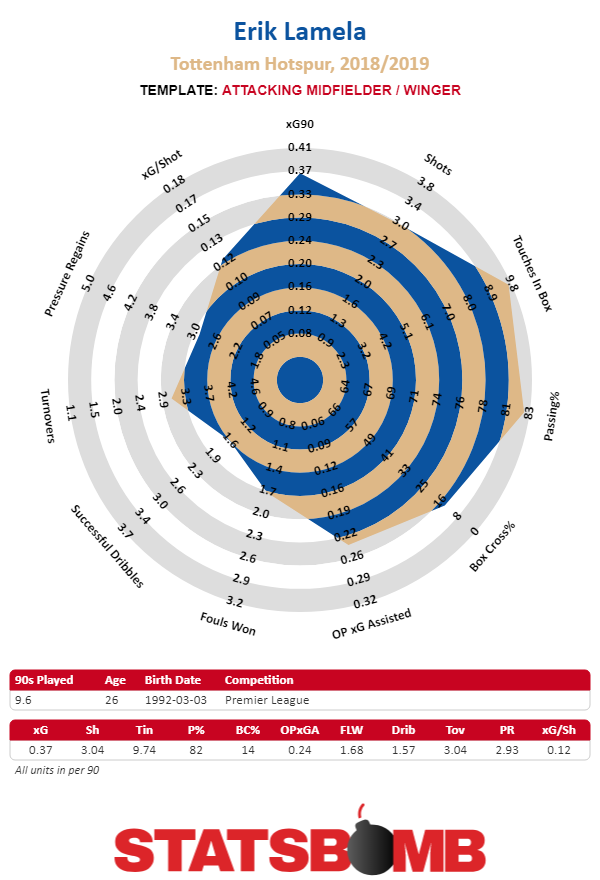 Then there’s Erik Lamela. Sometimes you buy a promising young winger — for argument’s sake, let’s call the selling club Roma — and they suddenly take the leap into Ballon d’Or contention. Other times you buy buy a promising young winger — once again let’s call the selling club Roma — and they turn out to be...pretty useful? Obviously you’d prefer the first outcome, but that doesn’t make the second one bad. Lamela has suffered from the expectation that he, of all the signings, would be Bale’s true successor and blossom into a goalscorer. That hasn’t really happened. But judged on his own term, as a tryhard who creates more than he scores while also fouling and pressing everyone in sight, he’s a good player. The caveat here is that Lamela’s per-90 statistics flatter a frequent substitute. Looking at Lamela’s unadjusted season totals, though, just drops him from being the second-best player in a variety of creative metrics to a decent fourth. (He still has the team’s second most throughballs, ranks fourth in expected goals, and a joint fourth with Dele Alli in scoring contribution.) The suboptimal outcome for a good, young player purchased for £27m, even in 2013, can still be quite good. Roberto Soldado, who showed some promise under Andre Villas Boas, was the most obvious flop. He was the oldest and most expensive player Spurs signed in 2013, never came close to scoring his promised 20 goals despite being in his prime, and lost much of his value in his two years with the club before being sold at a substantial loss. Negredo and Jovetic — the other strikers who came into the league for similar money that summer — weren’t great either, but Soldado was genuinely bad. There not being an obviously better option doesn’t change that fact. The other players at least took minutes away from some of the duds in the squad before being sold on at minor losses after a couple years. Nacer Chadli, the pick of that bunch, was a competent player who was sold on for basically the same nominal fee Spurs had spent in 2013. In the case of the more aged Paulinho, Spurs were bailed out by the existence of the Chinese Super League, but that’s what it’s there for. Chadli and Capoue went on to have useful careers lower down the Premier League table. Chiriches offers some depth at Napoli. Other than Paulinho, whose career is decidedly weird, these players appear to have found their levels. A buying club might want more Eriksen-style hits, but the “more is more” portion of the transfer list generally performed as you’d expect. Spurs, in other words, signed one of the midfield bargains of the decade in Eriksen, a promising young attacker who turned out fine, a dud of a striker, and some squad players who did squad player things before being sold on. One can credibly argue that they more than broke even on the summer’s business. And it was nowhere close to enough. Sixth place flattered Spurs in 2013-14. The new players were supposed to at least competently eat up minutes, but Nabil Bentaleb played more than 1,000 league minutes in that first post-Bale season. Both Bentaleb and Ryan Mason topped the 2,000 league minute mark in Mauricio Pochettino’s first season despite being, well, not very good at midfield things. You can, it turns out, get decent returns on your spending spree to replace a superstar and still end up much worse off. More than anything else, the lesson of Tottenham’s 2013 transfer travails may be that elite players — even the ones who bring in record fees — can be undervalued. Bale was known to make up for Tottenham’s talent deficit, but the extent of that deficit only became clear after he left. (This is likely less of an issue for other record sellers like Barcelona or Juventus, who have more talented squads.) Spurs made out okay with their Bale money, and it still took a major managerial upgrade, multiple good signings in subsequent windows, and the elevation of one of the league’s best strikers from the youth ranks for them to return to competitive relevance. A club can’t count on a grab bag of signings to replace the production of a superstar in the best of circumstances, but when those signings are purchased with a windfall that doesn’t reflect the lost star’s value the whole undertaking is basically impossible. Header image courtesy of the Press Association
Then there’s Erik Lamela. Sometimes you buy a promising young winger — for argument’s sake, let’s call the selling club Roma — and they suddenly take the leap into Ballon d’Or contention. Other times you buy buy a promising young winger — once again let’s call the selling club Roma — and they turn out to be...pretty useful? Obviously you’d prefer the first outcome, but that doesn’t make the second one bad. Lamela has suffered from the expectation that he, of all the signings, would be Bale’s true successor and blossom into a goalscorer. That hasn’t really happened. But judged on his own term, as a tryhard who creates more than he scores while also fouling and pressing everyone in sight, he’s a good player. The caveat here is that Lamela’s per-90 statistics flatter a frequent substitute. Looking at Lamela’s unadjusted season totals, though, just drops him from being the second-best player in a variety of creative metrics to a decent fourth. (He still has the team’s second most throughballs, ranks fourth in expected goals, and a joint fourth with Dele Alli in scoring contribution.) The suboptimal outcome for a good, young player purchased for £27m, even in 2013, can still be quite good. Roberto Soldado, who showed some promise under Andre Villas Boas, was the most obvious flop. He was the oldest and most expensive player Spurs signed in 2013, never came close to scoring his promised 20 goals despite being in his prime, and lost much of his value in his two years with the club before being sold at a substantial loss. Negredo and Jovetic — the other strikers who came into the league for similar money that summer — weren’t great either, but Soldado was genuinely bad. There not being an obviously better option doesn’t change that fact. The other players at least took minutes away from some of the duds in the squad before being sold on at minor losses after a couple years. Nacer Chadli, the pick of that bunch, was a competent player who was sold on for basically the same nominal fee Spurs had spent in 2013. In the case of the more aged Paulinho, Spurs were bailed out by the existence of the Chinese Super League, but that’s what it’s there for. Chadli and Capoue went on to have useful careers lower down the Premier League table. Chiriches offers some depth at Napoli. Other than Paulinho, whose career is decidedly weird, these players appear to have found their levels. A buying club might want more Eriksen-style hits, but the “more is more” portion of the transfer list generally performed as you’d expect. Spurs, in other words, signed one of the midfield bargains of the decade in Eriksen, a promising young attacker who turned out fine, a dud of a striker, and some squad players who did squad player things before being sold on. One can credibly argue that they more than broke even on the summer’s business. And it was nowhere close to enough. Sixth place flattered Spurs in 2013-14. The new players were supposed to at least competently eat up minutes, but Nabil Bentaleb played more than 1,000 league minutes in that first post-Bale season. Both Bentaleb and Ryan Mason topped the 2,000 league minute mark in Mauricio Pochettino’s first season despite being, well, not very good at midfield things. You can, it turns out, get decent returns on your spending spree to replace a superstar and still end up much worse off. More than anything else, the lesson of Tottenham’s 2013 transfer travails may be that elite players — even the ones who bring in record fees — can be undervalued. Bale was known to make up for Tottenham’s talent deficit, but the extent of that deficit only became clear after he left. (This is likely less of an issue for other record sellers like Barcelona or Juventus, who have more talented squads.) Spurs made out okay with their Bale money, and it still took a major managerial upgrade, multiple good signings in subsequent windows, and the elevation of one of the league’s best strikers from the youth ranks for them to return to competitive relevance. A club can’t count on a grab bag of signings to replace the production of a superstar in the best of circumstances, but when those signings are purchased with a windfall that doesn’t reflect the lost star’s value the whole undertaking is basically impossible. Header image courtesy of the Press Association
Reflections on David Neres: One Year Later
David Neres was one of the most conflicting prospects I’ve come across over the past couple of years. His ability to create goals for himself or others last season (25 combined goals an assists in less than 3000 Eredivisie minutes for a 20 year old was super impressive), along with credible shot contribution rates, made his productivity stand out in a very positive light. Even accounting for the Eredivisie being weird, and Ajax having a huge talent advantage within it, Neres passed the type of statistical benchmarks that you would hope for from a young attacker with flying colors.
But after watching film of Neres, I got scared by some of the flaws in his game, to the point that I rated Malcom as the better prospect t the time. I valued his elite athleticism and functional playmaking more than Neres’ elite coordination on-ball. Now it’s interesting to look back at that comparison 13 months later. That was probably close to the peak of where Malcom was as a young prospect, and he’s effectively lost an entire season of development at Barcelona. It’s tough to say whether this lost season will have a major effect on Malcom’s overall trajectory as a prospect, or if he’ll get a move to a club that he can get actual game time and this is just a bump on the road.
Neres hasn’t faced that same issue, despite Ajax's the acquisition of Dusan Tadic over the summer from Southampton cutting into available game time at the attacking positions. Instead of playing over 3000 minutes in both the Eredivisie and European competition like he did last season, Neres will probably end up playing closer to 2500 minutes, which is still not an insignificant number given that precocious young talents need game time to grow. Just like last season, he’s producing at a level that is comparable with almost anyone near his age.
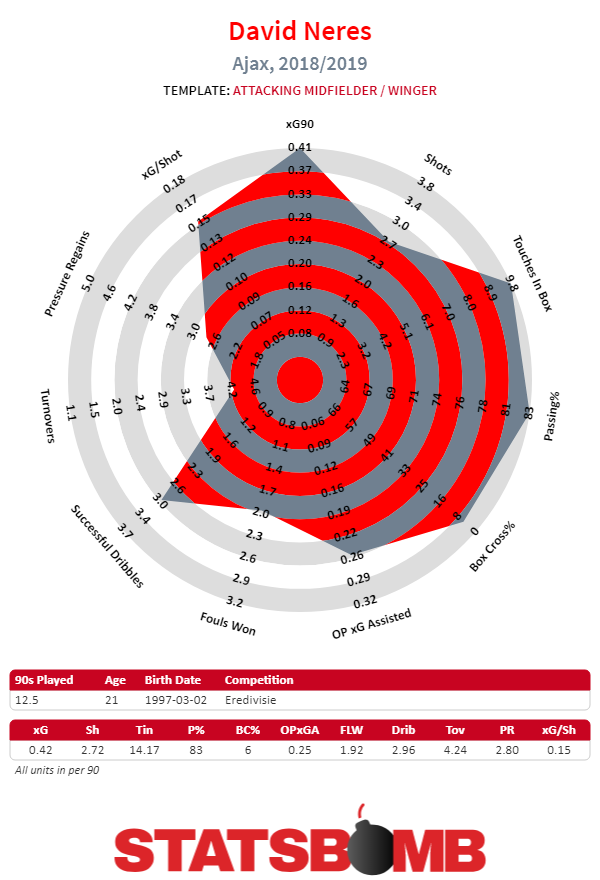
What’s been interesting with Neres this season has been the degree of freedom with his positioning. He’s featured a lot in the left halfspace when play has progressed into the final third, where he's trying to strike up combination plays. From there, he can make runs into the box through either the wide left channel or by going through the middle of the box. If he's in the right halfspace, there's the chance for him to try and cut into the middle and either pass it to someone dangerous with his quality touch on passes or recycle the ball to a nearby teammate. While he wasn't quite restricted to only being an inverted winger from the right side last season, his freer role this season has probably helped in attempting to destabilize the opposition with his positioning.
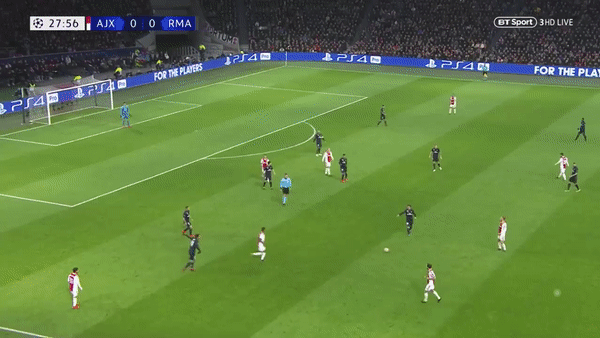
One aspect of Neres's game that has become more apparent over the last year is his off-ball speed and the type of damage he can do with it. Neres’ ability to sense danger behind the backline is strong and he’s constantly on his toes looking to receive passes in space. His off-ball speed is elite, and given that many of his runs originate from the halfspace, it gives him a greater ability to be a threat for long passes. Given that he's playing on a squad that features high caliber passers, particularly Hakim Ziyech and his penchant for attempting high value passes with regularity, Neres is in the perfect environment to leverage his speed.
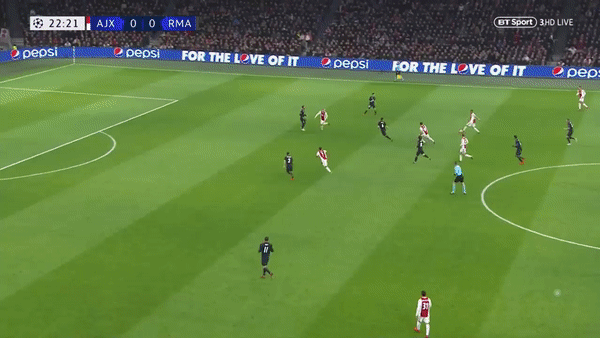 As it was last season, Neres's biggest appeal is that he has the type of coordination on-ball that you see from very few attacking talents. He's able to thread a pass between defenders and get the ball into dangerous spots with regularity. One can nitpick and say he's largely doing this against Eredivisie competition, but I'm pretty confident he'll be above average with his forward passing and overall chance creation even though the majority of them come from his left foot.
As it was last season, Neres's biggest appeal is that he has the type of coordination on-ball that you see from very few attacking talents. He's able to thread a pass between defenders and get the ball into dangerous spots with regularity. One can nitpick and say he's largely doing this against Eredivisie competition, but I'm pretty confident he'll be above average with his forward passing and overall chance creation even though the majority of them come from his left foot. 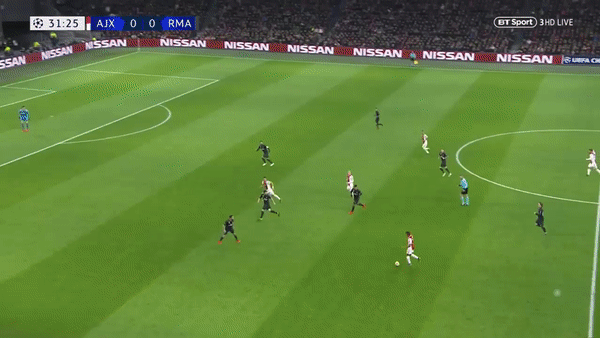 Neres is one of those young players who you don't have to worry about reigning in shot selection or wondering whether he'll waste possessions settling for low quality shots. He has about as clean a shot map as one could hope for from a young talent, and he provides value in that respect because it's not too often that you find 18-21 year old attackers who take shots at an average expected goal per shot value of 0.16. His judicious shot selection is a byproduct of a couple of things: he plays on one of the two major clubs in the Netherlands and that can skew numbers in a positive manner for players. Also, he is very hesitant to taking shots with his right foot so you end up cutting out potential shots from cutting inwards off the left wing, the type of shot that is a staple of wide attacking talents.
Neres is one of those young players who you don't have to worry about reigning in shot selection or wondering whether he'll waste possessions settling for low quality shots. He has about as clean a shot map as one could hope for from a young talent, and he provides value in that respect because it's not too often that you find 18-21 year old attackers who take shots at an average expected goal per shot value of 0.16. His judicious shot selection is a byproduct of a couple of things: he plays on one of the two major clubs in the Netherlands and that can skew numbers in a positive manner for players. Also, he is very hesitant to taking shots with his right foot so you end up cutting out potential shots from cutting inwards off the left wing, the type of shot that is a staple of wide attacking talents. 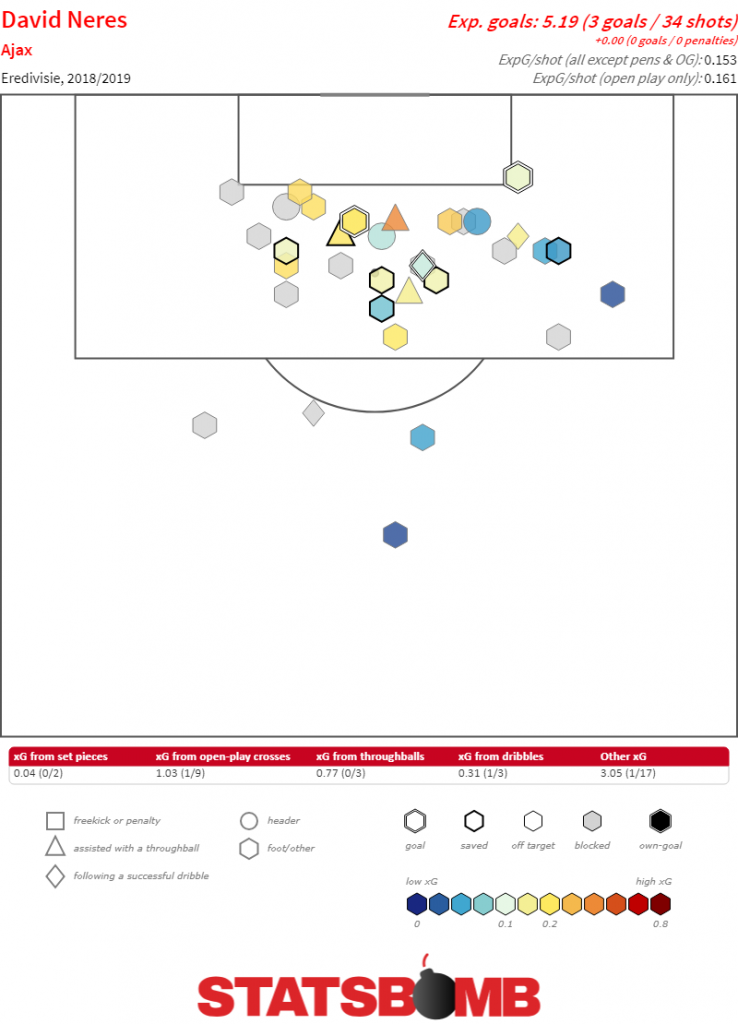 That reluctance to use his right foot is a key trait with Neres. It's not breaking ground to suggest that players are more likely to favor one foot than the other, and it's rare to find players like Ousmane Dembele who bring legitimate value by being both confident as a two-footed player and actually having the results to back it up (Justin Kluivert is an example of someone that has the confidence but more erratic results). But Neres is an extreme case and closer to being an outlier type in terms of dependence on his favored foot, even with the glimpses of decent right footed passes that you'll see from him. This isn't necessarily the worst thing in the world because he's got such a quality left foot to help compensate, but you'll see this flare up every now and then in a stark manner.
That reluctance to use his right foot is a key trait with Neres. It's not breaking ground to suggest that players are more likely to favor one foot than the other, and it's rare to find players like Ousmane Dembele who bring legitimate value by being both confident as a two-footed player and actually having the results to back it up (Justin Kluivert is an example of someone that has the confidence but more erratic results). But Neres is an extreme case and closer to being an outlier type in terms of dependence on his favored foot, even with the glimpses of decent right footed passes that you'll see from him. This isn't necessarily the worst thing in the world because he's got such a quality left foot to help compensate, but you'll see this flare up every now and then in a stark manner. 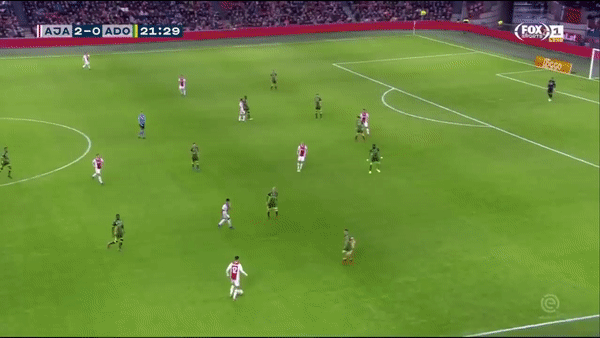 If there's one play that crystallizes both the good and bad with Neres as a young talent, it would be this one. The good is that there are a lot of players who would receive the ball in this position and then turn and take a speculative shot, which is a waste of a possession. The bad part is that there's an opportunity to carry the ball into the right side of the box for perhaps an individual shooting chance or a cutback for a teammate, the latter being a somewhat decent possibility because the team has a man advantage in the box. Someone who was a higher caliber athlete would've bet on himself to beat his man off the dribble and get to his spot. Given that he's going up against Eredivisie defenses, which aren't exactly renown for being stout, these instances help reinforce the notion that Neres will have trouble with his athleticism on-ball outside of the Ajax cocoon.
If there's one play that crystallizes both the good and bad with Neres as a young talent, it would be this one. The good is that there are a lot of players who would receive the ball in this position and then turn and take a speculative shot, which is a waste of a possession. The bad part is that there's an opportunity to carry the ball into the right side of the box for perhaps an individual shooting chance or a cutback for a teammate, the latter being a somewhat decent possibility because the team has a man advantage in the box. Someone who was a higher caliber athlete would've bet on himself to beat his man off the dribble and get to his spot. Given that he's going up against Eredivisie defenses, which aren't exactly renown for being stout, these instances help reinforce the notion that Neres will have trouble with his athleticism on-ball outside of the Ajax cocoon. 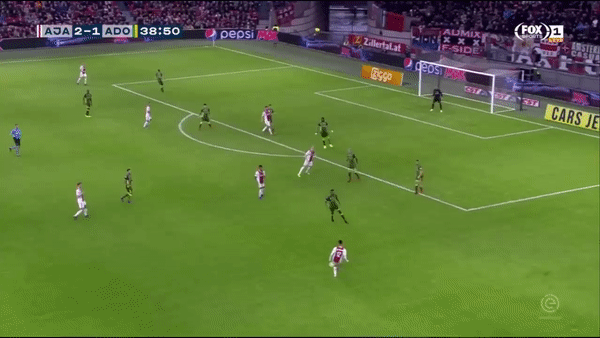 To a large extent, the conflicting feelings that I had a year ago with David Neres still persist when trying to think of his potential ceiling outcomes. You want to fall in love with him as a player because of parts of his skillset. He is an elite athlete off-ball and combines that with good timing for his runs, and this could be an x-factor for him being a huge success at his next club if utilized properly. I think he has good spatial awareness and is able to handle himself well during combination. Combine all that with very high level touch on his passing, and you've already covered a lot of what teams would want in a young wide player. And yet while he's generally good as a dribbler along with having very good shiftiness, another season has shown Neres to be overwhelmed at times when isolated against even mediocre defenders, along with being almost entirely dependent on his left foot. The good outweighs the bad with Neres and in a optimal environment, he could be a big time star, but clubs that are scouting him can't simply think of him as someone with such an overwhelming skillset that he'll be a unambiguous success in many situations. It's generally acknowledged that going to the right club is important for the developmental paths of young talents. With Neres, it's going to be especially important for him to find the perfect mix of squad and system fit given what he can and can't do. The good thing with Neres playing on Ajax and the team's success in Europe this season is that the worst club you could realistically expect for him to go to in the future would be ones who are on the outside looking in for Champions League spots (Arsenal being an example), but those clubs would have to ably replicate the setup Ajax have with their collective passing as a team to justify the high price tag that will come with a future Neres transfer. It's an interesting thought exercise to try and make player comparisons with Neres to visualize how he might fare outside of Ajax. Riyad Mahrez is an example of someone who like Neres has amazing technique with his left foot and broadly wouldn't be considered an overwhelming athlete, but along with having greater spontaneity in his dribbling, he's also better with right foot. Mahrez, during his absolute peak in 2015-16, was ruining defenders off the dribble and we've not seen that with Neres yet. Perhaps current day Erik Lamela (without the defensive value) is a better representation of how Neres is more likely to profile: being able to be an upper tier xG contributor without necessarily being an elite off the dribble threat (in the case of Lamela, that's more due to past injuries).
To a large extent, the conflicting feelings that I had a year ago with David Neres still persist when trying to think of his potential ceiling outcomes. You want to fall in love with him as a player because of parts of his skillset. He is an elite athlete off-ball and combines that with good timing for his runs, and this could be an x-factor for him being a huge success at his next club if utilized properly. I think he has good spatial awareness and is able to handle himself well during combination. Combine all that with very high level touch on his passing, and you've already covered a lot of what teams would want in a young wide player. And yet while he's generally good as a dribbler along with having very good shiftiness, another season has shown Neres to be overwhelmed at times when isolated against even mediocre defenders, along with being almost entirely dependent on his left foot. The good outweighs the bad with Neres and in a optimal environment, he could be a big time star, but clubs that are scouting him can't simply think of him as someone with such an overwhelming skillset that he'll be a unambiguous success in many situations. It's generally acknowledged that going to the right club is important for the developmental paths of young talents. With Neres, it's going to be especially important for him to find the perfect mix of squad and system fit given what he can and can't do. The good thing with Neres playing on Ajax and the team's success in Europe this season is that the worst club you could realistically expect for him to go to in the future would be ones who are on the outside looking in for Champions League spots (Arsenal being an example), but those clubs would have to ably replicate the setup Ajax have with their collective passing as a team to justify the high price tag that will come with a future Neres transfer. It's an interesting thought exercise to try and make player comparisons with Neres to visualize how he might fare outside of Ajax. Riyad Mahrez is an example of someone who like Neres has amazing technique with his left foot and broadly wouldn't be considered an overwhelming athlete, but along with having greater spontaneity in his dribbling, he's also better with right foot. Mahrez, during his absolute peak in 2015-16, was ruining defenders off the dribble and we've not seen that with Neres yet. Perhaps current day Erik Lamela (without the defensive value) is a better representation of how Neres is more likely to profile: being able to be an upper tier xG contributor without necessarily being an elite off the dribble threat (in the case of Lamela, that's more due to past injuries). 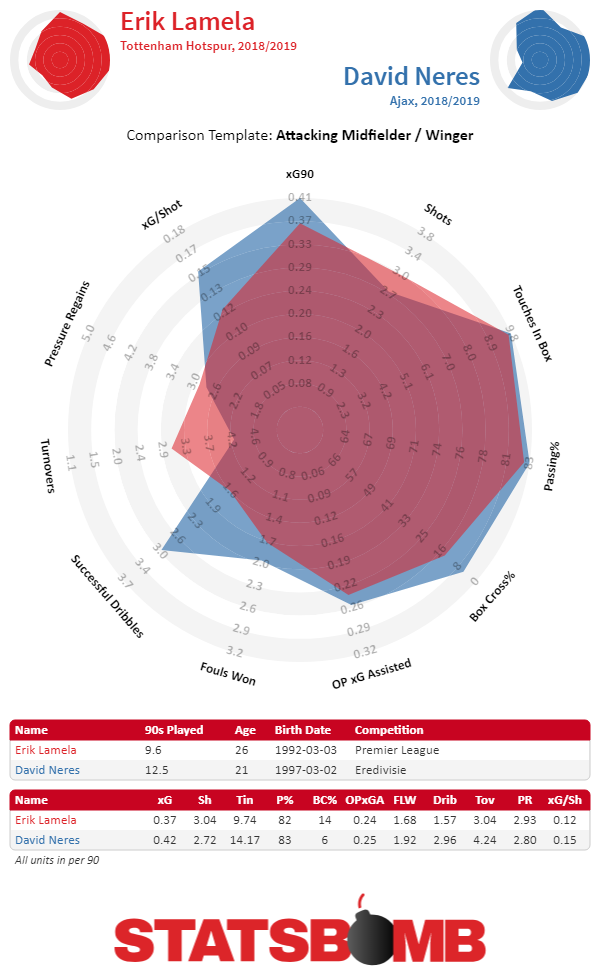 Whoever ends up being David Neres' next club after Ajax, whether that transfer occurs next summer or beyond that, will have to juggle all the factors mentioned previously along with even further extensive scouting before deciding on whether they're confident on him being a future star. Seeing as he's tied down to a contract until 2022 with Champions League money coming in this season for Ajax (not to mention a big fat Frenkie De Jong transfer fee), it would stand to reason that Neres' future fee will not come cheap. I am on the more skeptical end of the spectrum when it comes to Neres, and while I don't suspect he'll be a bust in a tougher league, I am more confident in Steven Bergwijn being a star talent outside the Eredivisie than I am with Neres. This could end up being entirely off the mark and Neres ends up being a stud, but he's the type of young Eredivisie talent where it's fair to be more skeptical of despite the gaudy statistical profile.
Whoever ends up being David Neres' next club after Ajax, whether that transfer occurs next summer or beyond that, will have to juggle all the factors mentioned previously along with even further extensive scouting before deciding on whether they're confident on him being a future star. Seeing as he's tied down to a contract until 2022 with Champions League money coming in this season for Ajax (not to mention a big fat Frenkie De Jong transfer fee), it would stand to reason that Neres' future fee will not come cheap. I am on the more skeptical end of the spectrum when it comes to Neres, and while I don't suspect he'll be a bust in a tougher league, I am more confident in Steven Bergwijn being a star talent outside the Eredivisie than I am with Neres. This could end up being entirely off the mark and Neres ends up being a stud, but he's the type of young Eredivisie talent where it's fair to be more skeptical of despite the gaudy statistical profile.
Sarri Must Show Progress Despite Chelsea's Imperfections
Chelsea are going the wrong direction. While the idea that they were in the title hunt might always have been fanciful, their performances, combined with their underlying numbers suggested they’d at least cruise to third while playing significantly better than the teams behind them. That hasn’t happened, and instead they find themselves in a fight for their top four lives. As Chelsea’s table position has deteriorated, so have their performances. It’s not simply that Chelsea’s results, which outstripped their level of play during the early months of the season, have returned to their underlying numbers, it’s that their underlying numbers have gotten worse. 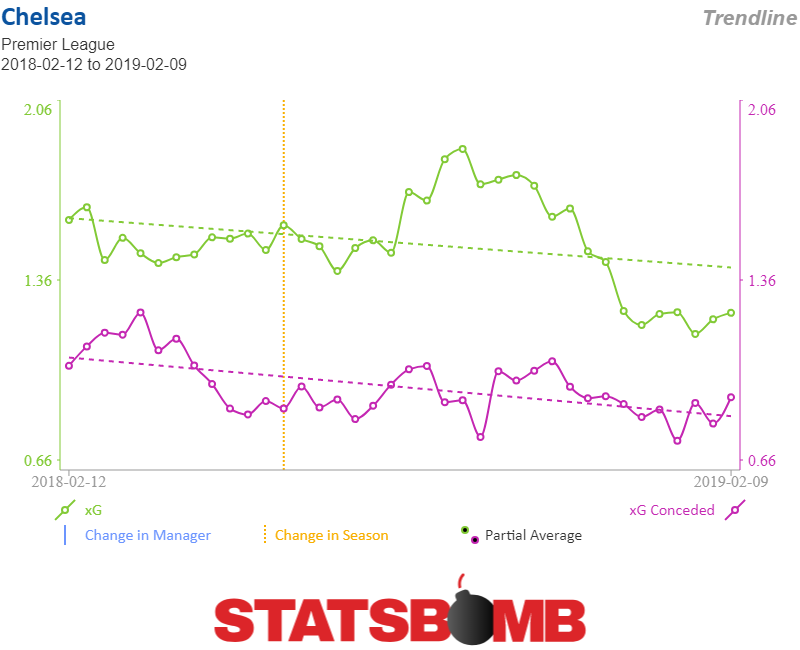 The fact that there has been a noticeable decline in the team complicates most defenses of manager Maurizio Sarri. While it was always reasonable to expect a new manager to take some time to successfully introduce a new style of play, the fact that the team is actually getting worse as the season progresses, does not suggest a side that is slowly being brought along into a new style. This isn’t the story of a team that had some growing pains adapting from Antonio Conte’s primarily off ball approach to Sarri’s possession heavy attempt. It’s rather the story of a side that is not picking up his approach effectively at all. Accordingly, the defense of Sarri has shifted. Now, it’s that the squad is simply poorly constructed for Sarri, and that a club which was built to succeed under Antonio Conte could never become a side capable of playing Sarriball without a complete overhaul first (a task which has incidentally been made harder by a transfer ban handed down by FIFA, although one which could reasonably be delayed by appeal). There are three problems with this defense. The first is historical. Sarri took over Napoli in the summer of 2015. In his first season he finished second in Serie A with 82 points. That was a massive 19-point improvement over the team’s previous fifth place season. And it’s not like he took over from a similar manager. Rafa Benitez had previously been in charge, and while Rafa has many strengths, intricate possession based football is not exactly one of them. So, the last time Sarri took over a club, he took a team that had been struggling, playing a different brand of football and immediately improved them dramatically in his first season. And while it might not have been reasonable to expect the same degree of immediate success in England, expecting demonstrable progress is a pretty low bar. It’s one that Sarri has, so far, failed to clear. But, wait, I hear you cry, didn’t Napoli remake their roster for Sarri when he showed up? The answer to that is… kind of, and it brings us to the second problem with saying that it’s important to wait for Sarri to have his players in place. The current Chelsea squad already looks very very different from the one Conte deployed last season. At Napoli, in Sarri’s first summer, the team moved on from Gokhan Inler in midfield and brought in Allan from Udinese. Quite quickly he became an integral part of Sarri’s midfield. The team also brought in two players from his old club, Empoli; Elseid Hysaj who became a regular at fullback and Mirko Valdifiori a defensive midfielder who you’ve never heard of. Chelsea, similarly did a lot of work to overhaul this squad for Sarri last summer. In order to facilitate moving from a manager who was happy not to have the ball to one who’s possession hungry, Chelsea went out and got a new midfield. They not only bought Sarri Jorginho, the midfield pivot from his old side, but also Mateo Kovačić on loan from Real Madrid. Additionally, after they assented to Thibaut Courtois’ demands to move to Real Madrid, they brought in Kepa Arrizabalaga to replace him, emphasizing the need for a keeper who can play with his feet. One problem though, Kepa has not played particularly well with his hands, and is putting up a decidedly subpar shot stopping season.
The fact that there has been a noticeable decline in the team complicates most defenses of manager Maurizio Sarri. While it was always reasonable to expect a new manager to take some time to successfully introduce a new style of play, the fact that the team is actually getting worse as the season progresses, does not suggest a side that is slowly being brought along into a new style. This isn’t the story of a team that had some growing pains adapting from Antonio Conte’s primarily off ball approach to Sarri’s possession heavy attempt. It’s rather the story of a side that is not picking up his approach effectively at all. Accordingly, the defense of Sarri has shifted. Now, it’s that the squad is simply poorly constructed for Sarri, and that a club which was built to succeed under Antonio Conte could never become a side capable of playing Sarriball without a complete overhaul first (a task which has incidentally been made harder by a transfer ban handed down by FIFA, although one which could reasonably be delayed by appeal). There are three problems with this defense. The first is historical. Sarri took over Napoli in the summer of 2015. In his first season he finished second in Serie A with 82 points. That was a massive 19-point improvement over the team’s previous fifth place season. And it’s not like he took over from a similar manager. Rafa Benitez had previously been in charge, and while Rafa has many strengths, intricate possession based football is not exactly one of them. So, the last time Sarri took over a club, he took a team that had been struggling, playing a different brand of football and immediately improved them dramatically in his first season. And while it might not have been reasonable to expect the same degree of immediate success in England, expecting demonstrable progress is a pretty low bar. It’s one that Sarri has, so far, failed to clear. But, wait, I hear you cry, didn’t Napoli remake their roster for Sarri when he showed up? The answer to that is… kind of, and it brings us to the second problem with saying that it’s important to wait for Sarri to have his players in place. The current Chelsea squad already looks very very different from the one Conte deployed last season. At Napoli, in Sarri’s first summer, the team moved on from Gokhan Inler in midfield and brought in Allan from Udinese. Quite quickly he became an integral part of Sarri’s midfield. The team also brought in two players from his old club, Empoli; Elseid Hysaj who became a regular at fullback and Mirko Valdifiori a defensive midfielder who you’ve never heard of. Chelsea, similarly did a lot of work to overhaul this squad for Sarri last summer. In order to facilitate moving from a manager who was happy not to have the ball to one who’s possession hungry, Chelsea went out and got a new midfield. They not only bought Sarri Jorginho, the midfield pivot from his old side, but also Mateo Kovačić on loan from Real Madrid. Additionally, after they assented to Thibaut Courtois’ demands to move to Real Madrid, they brought in Kepa Arrizabalaga to replace him, emphasizing the need for a keeper who can play with his feet. One problem though, Kepa has not played particularly well with his hands, and is putting up a decidedly subpar shot stopping season. 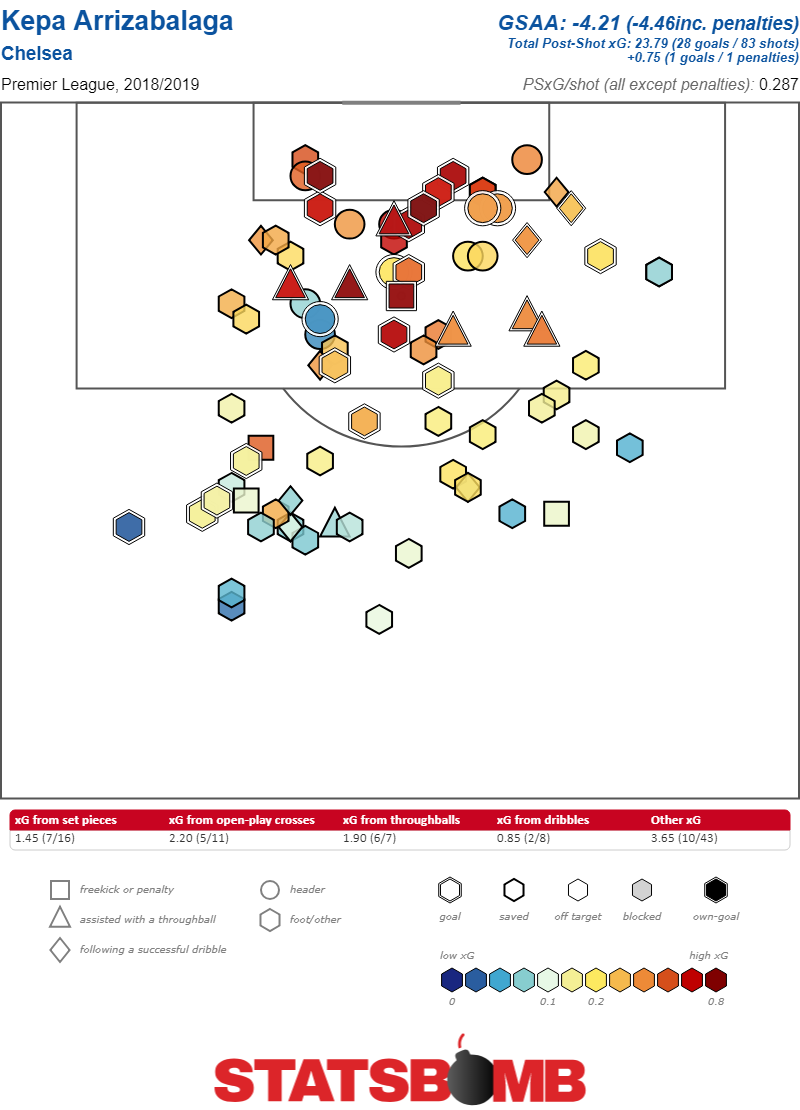 Then, as Chelsea struggled, the team once again went out and brought in an old Sarri hand, Gonzalo Higuain, to lead the line. Over a third of Chelsea’s regular starting lineup is new this season. The problem is as much that the new players, the ones bought for Sarri, aren’t performing, as much as it is that the old guard are holding the team back. It’s reasonable for a manager to struggle with a squad that doesn’t fit his needs, it’s way less so to claim that completely remaking the midfield and bringing in his old star striker isn’t enough of a makeover to expect results. But maybe that really is the problem. Maybe no matter what Chelsea did, this team could not succeed given how their winger situation is currently constituted. It’s at least worth considering that Pedro and Willian are simply an impossible match for this system. They’re both past 30 and maybe those old dogs simply ain’t about to learn any new tricks. On top of that, maybe Hazard, great as he is, isn’t particularly suited to this system that needs him to play more as a goal scorer than leading the break in transition. Even this isn’t a great defense of Sarri. After all, Sarri keeps playing them. This is the final frustrating point. What would be the point of continuing to play two wingers who are over 30 if they are simply never going to be good enough in the system Sarri wants to play, when you not only have Callum Hudson-Odoi waiting in the wings, but another young replacement in Christian Pulisic coming this summer. Sure, maybe Hudson-Odoi isn’t ready, but in that case, it would make more sense to tweak the system to get the most out of the players on the pitch (in the understanding that they won’t still be there when better fitting players come in). Both playing Willian and Pedro, and not adjusting the system to get the most out of them, while leaving Hudson-Odoi on the bench is the worst of all possible worlds. The question at hand for Chelsea is, should (assuming they can delay a transfer ban via appeal) they continue to remake this squad in Sarri’s image? It’s a big risk to put all your eggs in the Sarri basket, especially with a transfer ban looming. Before committing to that project Chelsea need to take a long hard look at why his transition with this side has been so much rougher than his transition at Napoli was. It’s certainly true that the situation at Chelsea isn’t perfect for Sarri, but the situation at Napoli wasn’t either. There, he made do. Now he’s banging square pegs into round holes, shrugging and saying, I’ll be better when I have some round pegs. It might be true, but other managers out there are better at reshaping those pegs. The situation certainly hasn’t been perfect for Sarri at Chelsea, and maybe if it was we’d see him become a roaring success. But most managers don’t get to deal with perfect situations, and it’s now time to wonder exactly how much imperfect Sarri is capable of dealing with while still getting results. If Sarri can’t point to some sort of progress after replacing a third of his starters with new acquisitions, maybe Chelsea shouldn’t be so confident that he’ll be destined to succeed if they just replace the rest of them. Header image courtesy of the Press Association
Then, as Chelsea struggled, the team once again went out and brought in an old Sarri hand, Gonzalo Higuain, to lead the line. Over a third of Chelsea’s regular starting lineup is new this season. The problem is as much that the new players, the ones bought for Sarri, aren’t performing, as much as it is that the old guard are holding the team back. It’s reasonable for a manager to struggle with a squad that doesn’t fit his needs, it’s way less so to claim that completely remaking the midfield and bringing in his old star striker isn’t enough of a makeover to expect results. But maybe that really is the problem. Maybe no matter what Chelsea did, this team could not succeed given how their winger situation is currently constituted. It’s at least worth considering that Pedro and Willian are simply an impossible match for this system. They’re both past 30 and maybe those old dogs simply ain’t about to learn any new tricks. On top of that, maybe Hazard, great as he is, isn’t particularly suited to this system that needs him to play more as a goal scorer than leading the break in transition. Even this isn’t a great defense of Sarri. After all, Sarri keeps playing them. This is the final frustrating point. What would be the point of continuing to play two wingers who are over 30 if they are simply never going to be good enough in the system Sarri wants to play, when you not only have Callum Hudson-Odoi waiting in the wings, but another young replacement in Christian Pulisic coming this summer. Sure, maybe Hudson-Odoi isn’t ready, but in that case, it would make more sense to tweak the system to get the most out of the players on the pitch (in the understanding that they won’t still be there when better fitting players come in). Both playing Willian and Pedro, and not adjusting the system to get the most out of them, while leaving Hudson-Odoi on the bench is the worst of all possible worlds. The question at hand for Chelsea is, should (assuming they can delay a transfer ban via appeal) they continue to remake this squad in Sarri’s image? It’s a big risk to put all your eggs in the Sarri basket, especially with a transfer ban looming. Before committing to that project Chelsea need to take a long hard look at why his transition with this side has been so much rougher than his transition at Napoli was. It’s certainly true that the situation at Chelsea isn’t perfect for Sarri, but the situation at Napoli wasn’t either. There, he made do. Now he’s banging square pegs into round holes, shrugging and saying, I’ll be better when I have some round pegs. It might be true, but other managers out there are better at reshaping those pegs. The situation certainly hasn’t been perfect for Sarri at Chelsea, and maybe if it was we’d see him become a roaring success. But most managers don’t get to deal with perfect situations, and it’s now time to wonder exactly how much imperfect Sarri is capable of dealing with while still getting results. If Sarri can’t point to some sort of progress after replacing a third of his starters with new acquisitions, maybe Chelsea shouldn’t be so confident that he’ll be destined to succeed if they just replace the rest of them. Header image courtesy of the Press Association
Can Barcelona Find a Potential Jordi Alba Replacement?
Barcelona have got themselves into a bit of pickle with Jordi Alba’s contract. By failing to put an adequate succession line for the left-back in place, they have backed themselves into a corner whereby they could well end up spending significant money to extend for five years the contract of a player who turns 30 in March.
Alba’s current deal expires at end of the 2019-20 season, and he and his representatives are reported to be seeking a contract that brings him up to the wage bracket of those other mainstays of recent triumphs, Gerard Pique and Sergio Busquets. Barcelona’s opening offer was rejected at first sight. No further progress has been made.
His position has been strengthened by an excellent campaign that has yielded a career-high 13 assists in all competitions and seen him do pretty much all the things you’d want of a attack-minded full-back on a title-challenging team.

The key question is how long he can continue to produce that kind of output in one of the most physically demanding positions in the game. Even if he is able to do so for a couple more seasons, would it really be a smart move for a club who is already presiding over the highest wage bill in Europe, with the highest wages to turnover ratio of any of the richest clubs, to commit to a big-money five-year deal?
Without an experienced direct replacement in the current squad - central defenders, right-backs and 19-year-old, B-team left-back Juan Miranda have all filled in - their options look fairly limited. Poor results in Alba’s absence this season suggest that regardless of whether they eventually reach an agreement with him, they will still need another left-back next season to avoid the drop-off in performances when he is rested or otherwise unavailable.
The club’s scouting department presumably already have a list of names they’ve been monitoring, but here we are going to use some of our data to identify players with similar statistical profiles and attacking output to Alba.
Using the StatsBomb IQ similarity tool, here are the players who have played the majority of their minutes at left-back or left wing-back, aged 25 or under at the end of this season, in the top five European leagues, Portugal and the Netherlands, over the last couple of seasons, who have 80% or higher similarity to Alba, ranked from the best match downwards: Andrew Robertson (2018-19), Thomas Ouwejan, Luke Shaw, Benjamin Mendy, Kenneth Paal, Ludwig Angustinsson, Alejandro Grimaldo, Angeliño and Andrew Robertson (2017-18).
That provides a good starting point, and we’ll return to one of those names later on. But we need to refine that list further by seeking out players capable of providing a similar assist output to Alba. His seven assists in league play are buttressed by an open play xG assisted per 90 figure of 0.22 -- fifth amongst all left-backs in the top-five leagues this season.
Here are the players who, using the same age, positional and league criteria as before, have provided 0.15 or more open play xG assisted per 90 in either of the last two seasons: Angeliño, Andrew Robertson, Alfonso Pedraza, Benjamin Mendy, Konstantinos Tsimikas, Robin Gosens and Thomas Ouwejan. That leaves four players who tripped both of the filters: Andrew Robertson, Angeliño, Benjamin Mendy and Thomas Ouwejan. Mendy’s injury record rules him out as a viable option, leaving three to investigate further: Robertson, Angeliño and Ouwejan.
Andrew Robertson
By this point, the virtues of Andrew Robertson hardly require further enumeration. At Liverpool, the player whose spiky attacking output at Hull drew interest from bigger clubs has developed into one of the most complete players in his position in Europe.

The 24-year-old was the only player to meet the similarity score requirement in each of the two most recent seasons, while his open play xG assisted of 0.20 per 90 this season also ranks him towards the top of that list. Like Alba, he has provided seven assists in league play. It would certainly not be an inexpensive operation, but Barcelona would be getting the prime years of an ideal, like-for-like replacement for Alba, with experience at the top end of both domestic and European competition.
Angeliño
It should perhaps come as no surprise that Angeliño appears amongst the results given that he is a player who has been on Barcelona’s radar for some time. They were interested in him when he was a youth prospect at Deportivo La Coruña, before he moved to Manchester City, and they also considered him last summer, before his transfer to PSV Eindhoven. “He is a very good footballer,” a club source told El País in November. “He’s got speed, dribbling ability, and he gets forward well.” That much is evident in both his open play xG assisted figure of 0.23 per 90 and his overall statistical profile.

The 22-year-old has the sort of skill set that would be well-suited to Barcelona. He is able to get forward to the byline on the overlap or the dribble to deliver into the area. Having done so, he usually gets his head up to try and pick out a specific option.
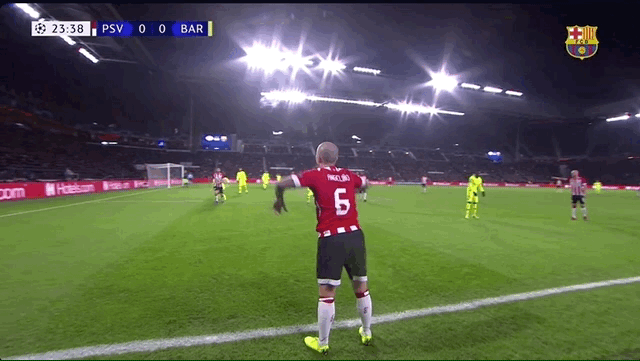
And he is also able to find teammates with direct balls down the line or cuter passes infield. He ranks third for PSV in deep progressions, with just over seven per 90.
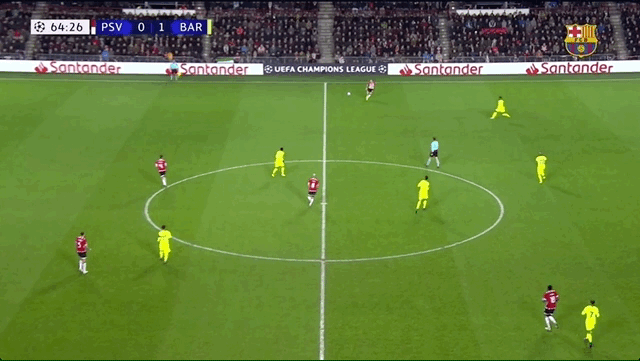
Unsurprisingly, his numbers were significantly worse in the Champions League. PSV were outclassed in a group alongside Barcelona, Tottenham Hotspur and Inter Milan, and his attributes were not as well-matched to the open, back-and-forth encounters that those matches became. He is not a long-striding, powerful full-back capable of regularly carrying the ball forward into attacking territory from deeper areas. But neither is that necessarily what Barcelona would be looking for. The primary point of concern would be Angeliño’s defensive capabilities. Particularly in relatively set defensive situations, he gives the impression of constantly being a step or two behind, reacting rather than anticipating. He also has a bad habit of setting himself a bit too square to his opponents, making it hard for him to adjust and prevent them getting past.
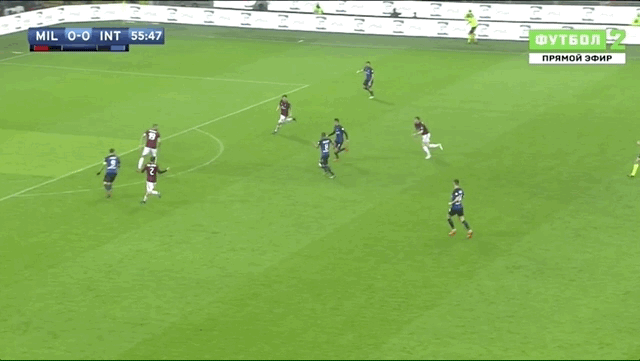
While his defensive work could be expected to improve with age, his weaknesses there may initially be even more noticeable against a higher average level of attacker, such as he would find in La Liga. But overall, with a further campaign of good numbers behind him, Angeliño represents a safer bet for Barcelona now than he would have been last summer. There would be a learning curve, for sure, but he looks as good a potential long-term successor for Alba as there is in the current market.
Thomas Ouwejan
Thomas Ouwejan triggered both of the filters, but did so in different seasons. His similarity score was based on his 2017-18 campaign, while his 0.15 open play xG assisted per 90 this time around saw him just sneak in under that criteria. His radar for this season at AZ Alkmaar displays a slightly different profile and one that squares with watching him in action.

The 22-year-old is generally a sensible, stay-on-his-feet defender, who concentrates on making himself difficult to get past. Going forward, he is a simple but efficient passer, and mainly progresses into advanced positions with overlapping runs past the skilled wide forward Oussama Idrissi. He is taller and more upright in his gait that Alba (and Robertson and Angeliño) and consequently less supple in changing direction in both offensive and defensive situations. He doesn’t possess a decisive change of pace. While Ouwejan is certainly someone that top-half clubs in the bigger leagues should be looking at, he isn’t someone who looks capable of replacing what Alba provides to Barcelona.
Other Options
If Barcelona are able to extend Alba for a lesser time period or even just retain him as a starter through the final season of his current contract, there are a couple of potentially cheaper options who would represent solid backups with room for further development. Alejandro Grimaldo featured on the similarity filter, but failed to make the cut on his attacking output, with just 0.06 open play xG assisted per 90 in his outings for Benfica in the Portuguese league. There are, though, a couple of things in his favour: firstly, he came through the Barcelona youth system and they are due a percentage of any future sale, which could be leveraged for a good deal; secondly, in an admittedly smaller sample, his numbers in the Champions League this season were very solid. The 23-year-old again profiled similarly to Alba (80%), while his open play xG assisted figure of 0.13 per 90 was much closer to the 0.15 per 90 cutoff we put in place.

Barcelona also currently have Marc Cucurella out on loan at Eibar. Largely a left-back in the Barcelona youth system, at Eibar he has mainly been employed on the left of midfield. An assist and standout performance in a 3-0 win over Real Madrid in November was the high point of a solid yet infrequently as spectacular campaign.

The 20-year-old has, though, showed himself capable of competing at a top-flight level and is unlikely struggle to find a place for himself in a Primera Division squad next season. What is much less certain is whether he has shown enough to convince Barcelona of his suitability for a place in theirs.
Attacking Contributions: Markov Models for Football
Messi or Ronaldo? Kroos or Modric? Mbappe or Neymar? Every football fan loves to argue over who they think is a better player. Depending on where your loyalties lie, arguments can range from simple statistics; like the number of goals they’ve scored or the trophies they have won, to advanced metrics like expected goal values from ghosting. To the layman football fan, the former argument is almost certainly more digestible. But for the rest of us, we often want a metric that’s more objective, more extendable, and more rigorous, while still being able to understand it and explain it to your counterpart to assert your football dominance.
The evolution of football analytics - how we got to non-shot expected goals models.
Every football analytics nerd understands the (slow) evolution of football statistics. The story begins with football’s notorious and frustratingly difficult objective of scoring goals, the historic hindrance for American spectating. Analyzing goals scored and goals conceded appeased few and people quickly realized the value of shot volume for depicting a team’s performance and ability. The obvious pitfall in comparing shot volume was the quality of a shot can vary drastically. This led to everyone under the sun defining their own expected goals (xG) model to objectify chance quality and aggregate goal likelihood as a better metric for attacking production. xG is now omnipresent in football analytics as a tool for attackers’ and teams’ performance. Most recently in the sports analytics community, people have extended the concept of expected goals to allocate ball progression contributions throughout a team’s possession of the ball.
Commonly referred to as “non-shot expected goals (NSxG) models”, these models are effective tools to quantify passes and carries into dangerous areas of the pitch, assigning value to actions other than shots and allowing for the comparison of attacking contribution of ALL players. Fivethirtyeight even uses a non-shot xG model as a component in their soccer projections.
The original research - before “non-shot expected goals” became a thing - was by Sarah Rudd, presented at NESSIS in 2011. Rudd used markov models to assign individuals offensive production values defined as the change in the probability of a possession ending in a goal from the previous state of possession to the current state of possession.
For example, imagine a player standing 30 yards from the goal line, close to the sideline. They are in a non-threatening position and that possession will rarely result in a goal. Let’s say it has a 1% chance of resulting in a goal. Now, that player gets a cross off, the defender clears it out of bounds for a corner kick. Corner kicks resulted in goals approximately 4% of the time. This play would attribute a +3% change in NSxG for the player who crossed the ball.
As data becomes increasingly utilized and accessible, the variants of NSxG models grow just as xG models did. Mark Taylor further explains NSxG models here. Nils Mackay defines “xG added” to grade passing skill and extends it to allocate value for carries and structures as a possession based model. Similarly (and most recently), Karun Singh published his version of xG added, introducing xG threat, explaining it with beautiful interactive visualizations.
All of this publicly facing research has been pivotal in advancing the applications and effectiveness of sports analytics. Today, I am going to walk through a tutorial on StatsBomb’s first iteration of a Ball Progression Model. I like to refer to NSxG as “contribution”, simply because it's easier to say and not everything in football analytics needs an “x” in it.
Markov Model - Framework and Methodology.
Adopting the framework set forth by Rudd, we construct a possession based markov model we call our “Ball Progression Model”. We define attacking possessions to have two possible outcomes, a Goal or a Turnover. In a markov model, these two outcomes are known as the “absorption states”. The most crucial condition of an absorption state is that the probability of transitioning out of the state is 0 and the probability of remaining in the state is 1, given that it is the end of a possession this condition holds and the data must be structured as such (this condition makes it more difficult to consider shots or xG bins as potential absorption states). Leading up to the absorption state, a possession can transition between any number of “transient states”. We define transient states based on the context of the state and the geographical location of the possession at a current state. Extending the states defined by Rudd and applying to StatsBomb data, we define the following context-based transient states:
- Attacking Third Free Kick
- Central Third Free Kick
- Defending Third Free Kick
- Attacking Third Throw In
- Central Third Throw In
- Defending Third Throw In
- Corner Kick
- Penalty Won
We then define the following geographic zones as transient states:
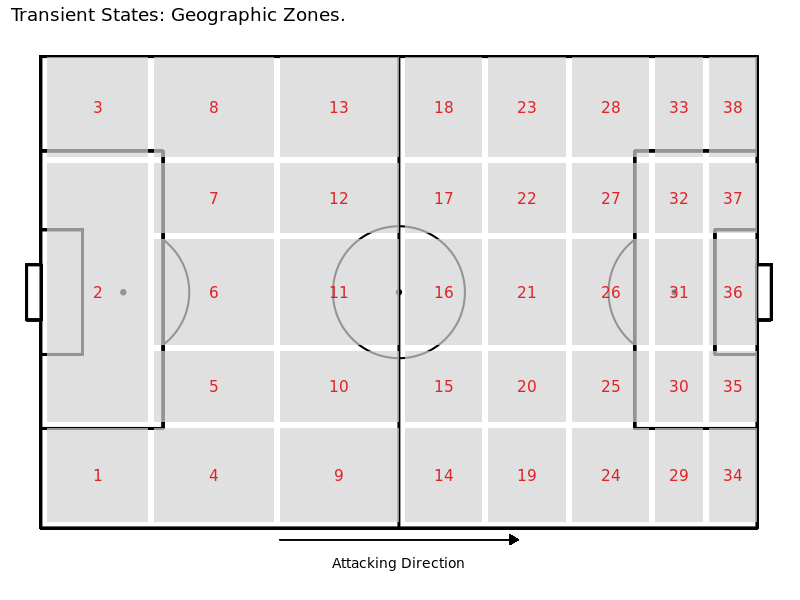 Since a state can depend greatly on defensive pressure, we define the geographic zones each when they are absent of pressure and when they are under pressure. This leaves us with 76 geographic zones (38 with pressure, 38 without pressure) and 8 contextual zones for a total of 84 transient states.
Since a state can depend greatly on defensive pressure, we define the geographic zones each when they are absent of pressure and when they are under pressure. This leaves us with 76 geographic zones (38 with pressure, 38 without pressure) and 8 contextual zones for a total of 84 transient states.
Transient states can transition between other transient states and ultimately an absorption state based on some observed transition probability. The transition probability is dependent only on the current state of the possession and is independent of previous states. This is known as the markov property and is a key assumption in markov models (in the discussion we consider this a limitation and propose extensions to this property). For instance, if you have the ball in zone 21, the probability that you pass the ball to zone 28 is the same regardless of the fact that the ball came from zone 14 as opposed to any other zone. This is known as the “memoryless” property.
Quick notation - n is the number of transient states (in our case 84), r is the number of absorbing states (in our case 2). Q is the matrix of transition probabilities, Q is n x n. R is the matrix of absorption probabilities, R is n x r. N is known as the fundamental matrix and it is calculated as the inverse to the n x n identity matrix, I, minus the transition matrix Q, formally N = (I - Q)-1 .
Calculations - for each transient state, we can calculate the expected number of plays (progressing actions: passes, carries, and shots) until absorption as the row sums of the fundamental matrix. Then, the probability of reaching either absorption state for the current transient state is equal to N x R. For more on the theory behind markov models, please see here. Special thanks to Ron Yurko for the code.
Results
We prepare the data (this is the most time consuming portion) and run our ball progression model for Europe’s big five leagues, England Championship and England League One for the 2017/2018 and 2018/2019 (through 2/18/19) seasons.
For each transient state, we calculate the probability of a goal in absorption as well as the expected number of plays until absorption. The three most likely states to result in a goal are (refer to geographic zones above): 36 w/ pressure (Pr(Goal) = 19.2%), 31 w/ pressure (Pr(Goal) = 9%), and 36 w/o pressure (Pr(Goal) = 8.3%). The three most likely zones to result in a turnover are: 1 w/ pressure (Pr(Turnover) = 99.5%), 3 w/ pressure (Pr(Turnover) = 99.5%), and 2 w/ pressure (Pr(Turnover) = 99.5%). We present a possession that resulted in a goal below, with the contribution value for each action.
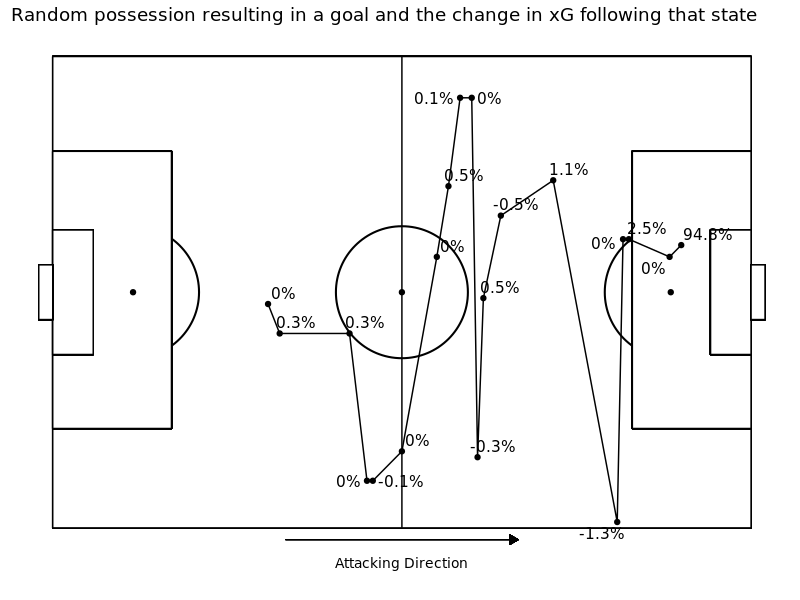 We then calculate our “contribution” metric as the change in the probability of a goal from the current state to the next state. Formally,
We then calculate our “contribution” metric as the change in the probability of a goal from the current state to the next state. Formally,
contribution = Pr(Goal|Statet+1) - Pr(Goal|Statet) for each transient state at time t.
We can also calculate total attacking contributions for each individual, i, as the sum of all of their attacking contributions,
contributioni = ∑Pr(Goal|Statet+1) - Pr(Goal|Statet)i ·I(action by player i)
We then scale their total contribution by the number of matches played to get a player’s “contribution per game”. We choose to leave the contribution per game metric raw, not standardizing by league strength. This is to simply to see the crude output from the model, giving every player a fair chance to shine regardless of where they play. The top five contributors for each position (attackers, midfielders, defenders and goalkeepers) are presented in the tables below:



We also formulate a hypothetical “Ultimate Team” for the top contributors for each position of a standard 4-4-2 against a 4-3-3. Again, we purposely make the naive assumption that contributions between different leagues are equal. We also, in order to show you some names you might know, purposely didn't stress that the ultimate teams are extremely broad and unrealistic when it comes to positional categorizations. The two squads we formulate highlight plenty of young stars to remember during the next transfer window.
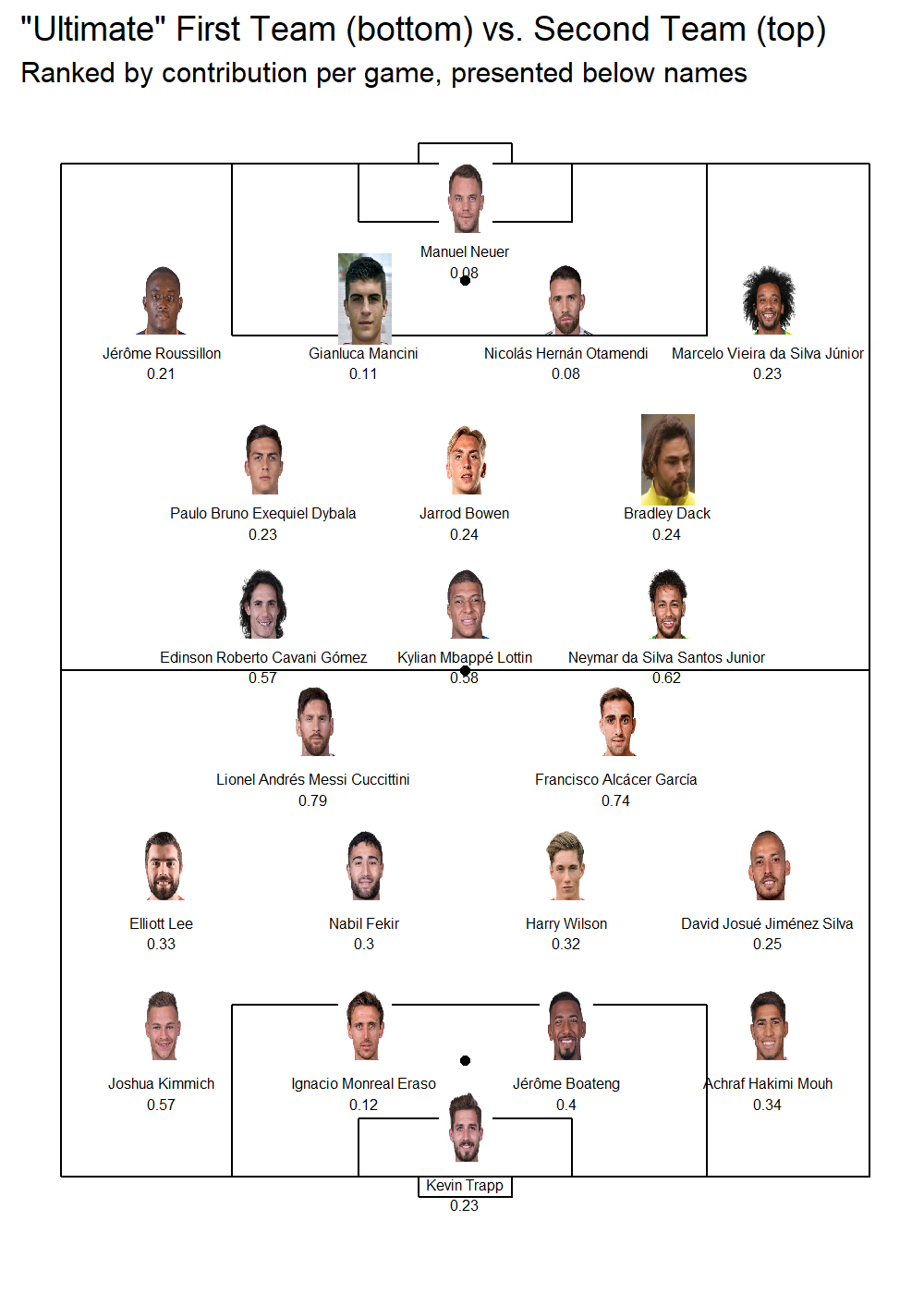 Discussion
Discussion
Our ball progression model has clearly identified the top players across Europe, and offers some justification for the money needed to acquire them. We have clearly designed a model that is easily interpretable even by the less-technical analytics sides. And ultimately, the model works without much computational power. Markov models are good at handling sequences of arbitrary length (as possessions in soccer can be anywhere from one event to 100s of events), and they allow for the attribution of final outcome contributions further along in the sequence. Nonetheless, there exist several limitations to a simple markov model.
- First, markov models’ assume the “memoryless” property when in reality a soccer possession is not memoryless. The probability of scoring when you are in a current state can depend on previous passes and carries leading up to the current state.
- A further extension of our ball progression model, that would appease this limitation, is higher order markov models. In higher order markov models, instead of assuming the markov property of independence, you assume that transition probabilities are conditionally independent based on the value of the current state and the value of the previous, 2nd previous, nth previous state, where the number of previous states you consider is the nth order of the markov model.
- Another limitation is that this simple markov model does not consider the action required to transition between states. For instance, the probability of a possession resulting in a goal may be different given that you passed into a zone vs. dribbled into a zone.
- Lastly, and perhaps the most obvious limitation of this markov model is the categorized structure of transient and absorption states. This causes the loss of information and limits applications especially in the free-flowing game of football.
- There exists some methods for continuous stochastic processes, but their use in the public sphere is limited and the concepts are far more difficult to understand.
This leads us to StatsBomb’s latest endeavor. Based on the limitations outlined above, we recognized the need for a model that accounts for the continuous nature of football, the retention of information from previous states, and the actions chosen by decision makers. Our next model will improve on the limitations noted above as well as layer on additional components essential to a football team’s success such as the timing of goals and the style of play under different game states. This will be the primary model we use for holistic ball progression in player and team stats, and a white paper detailing the model will be made available to current StatsBomb customers in March.
Can Marco Silva Fix Everton's Attacking Struggles?
What can data analytics tell us about Everton’s midfield? Everton have had a strange season, starting brightly but fading away. The rolling xG average tells the story with a sharp recent decrease in attacking productivity coupled with a large increase in the quality of chances against. 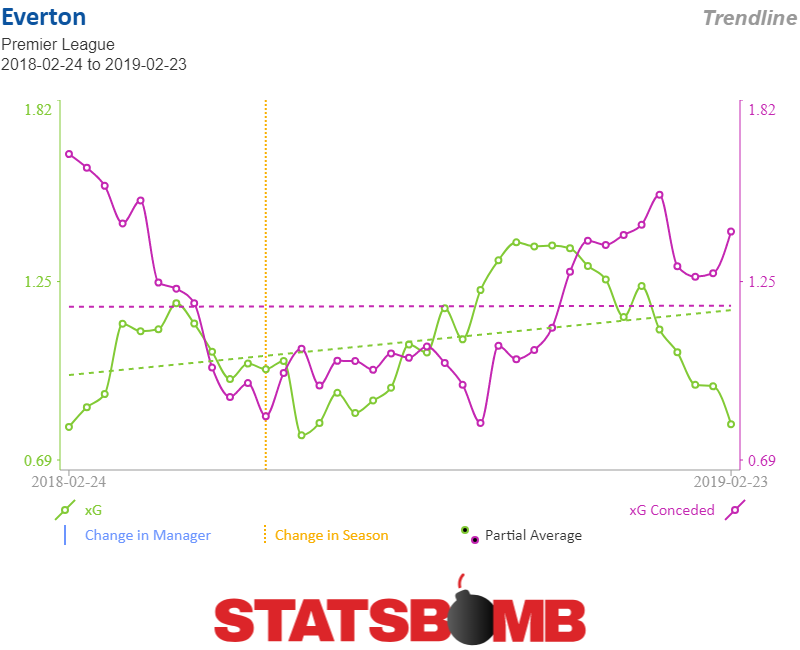 In almost every game this season Everton have lined up in a nominal 4-2-3-1 formation. The deeper two players have usually been Idrissa Gana Gueye and Andre Gomes. Ahead has been a left sided player, usually Bernard, a central player in Gylfi Sigurdsson and Theo Walcott on the right. Richarlison has often been the striker. In a 4-2-3-1 the deeper two players usually take responsibility for protecting the defence and feeding the ball to the attacking midfield and striker ahead of them. If we look at the player radars we can see that Gueye shows up very well on defensive covering stats, winning the ball back at league leading levels.
In almost every game this season Everton have lined up in a nominal 4-2-3-1 formation. The deeper two players have usually been Idrissa Gana Gueye and Andre Gomes. Ahead has been a left sided player, usually Bernard, a central player in Gylfi Sigurdsson and Theo Walcott on the right. Richarlison has often been the striker. In a 4-2-3-1 the deeper two players usually take responsibility for protecting the defence and feeding the ball to the attacking midfield and striker ahead of them. If we look at the player radars we can see that Gueye shows up very well on defensive covering stats, winning the ball back at league leading levels. 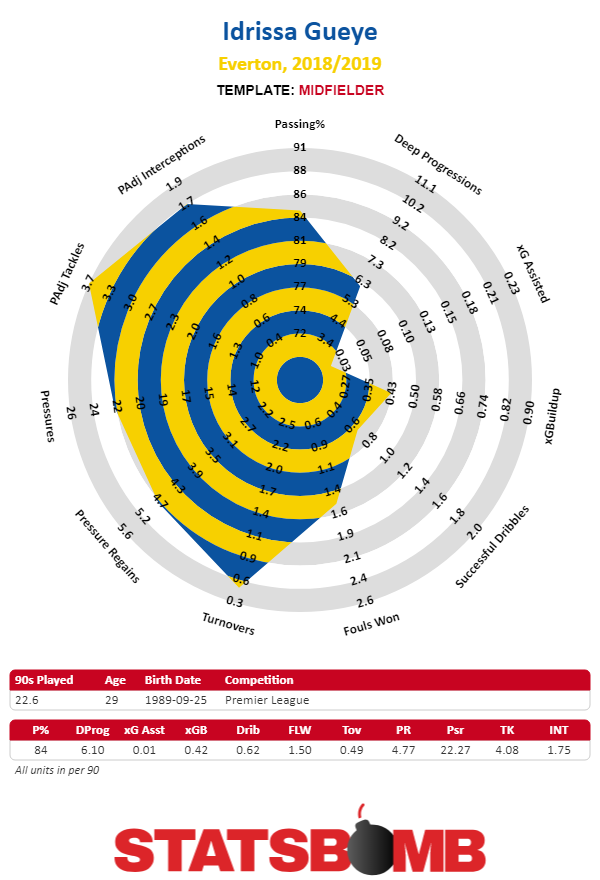 Gomes also shows signs of being able to carry the ball forwards maintaining a league average output for a central midfielder, coupled with above average dribbling stats.
Gomes also shows signs of being able to carry the ball forwards maintaining a league average output for a central midfielder, coupled with above average dribbling stats. 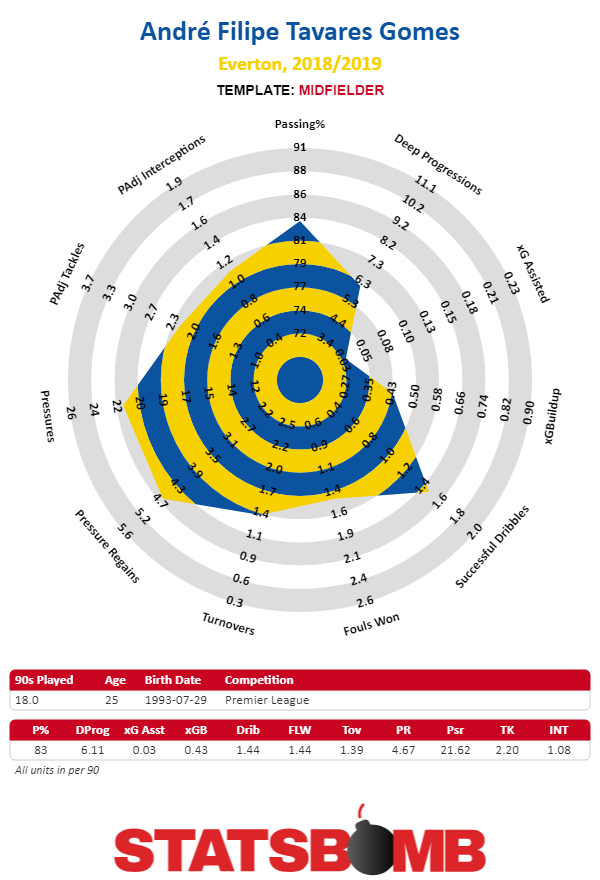 Drilling further into the Statsbomb dataset gives us more information. There are 111 midfielders who have played over 1000 minutes of first team football this season. To ensure a fair comparison we will compare Gueye and Gomes only with players described as midfielders, and Bernard, Sigurdsson and Walcott with attacking midfielders and wingers. There are 69 midfielders in our comparison group for Gueye and Gomes, for each of them we will provide a ranking from within that group of players: Open play expected assists per 90 rank: Gueye: 64/69 Gomes: 49/69 Open play passes per 90 rank: Gueye: 31/69 Gomes: 26/69 Opposition final third open play passes per 90 rank: Gueye: 44/69 Gomes: 37/69 These ranking results make sense, especially for two deep midfielders in a 4-2-3-1 formation. Everton are generating a reasonable volume of passes, but at low expected assist quality as those passes are taking place a long way from the opposition goal. Similarly ranked players, on these metrics, include Rueben Neves and Georginio Wijnaldum. The Everton pair are unlikely to be playing passes of the same quality but by way of showing where they are positioned on the pitch, and the type of passes they make, it seems reasonable. So how do the attacking midfield trio profile?
Drilling further into the Statsbomb dataset gives us more information. There are 111 midfielders who have played over 1000 minutes of first team football this season. To ensure a fair comparison we will compare Gueye and Gomes only with players described as midfielders, and Bernard, Sigurdsson and Walcott with attacking midfielders and wingers. There are 69 midfielders in our comparison group for Gueye and Gomes, for each of them we will provide a ranking from within that group of players: Open play expected assists per 90 rank: Gueye: 64/69 Gomes: 49/69 Open play passes per 90 rank: Gueye: 31/69 Gomes: 26/69 Opposition final third open play passes per 90 rank: Gueye: 44/69 Gomes: 37/69 These ranking results make sense, especially for two deep midfielders in a 4-2-3-1 formation. Everton are generating a reasonable volume of passes, but at low expected assist quality as those passes are taking place a long way from the opposition goal. Similarly ranked players, on these metrics, include Rueben Neves and Georginio Wijnaldum. The Everton pair are unlikely to be playing passes of the same quality but by way of showing where they are positioned on the pitch, and the type of passes they make, it seems reasonable. So how do the attacking midfield trio profile? 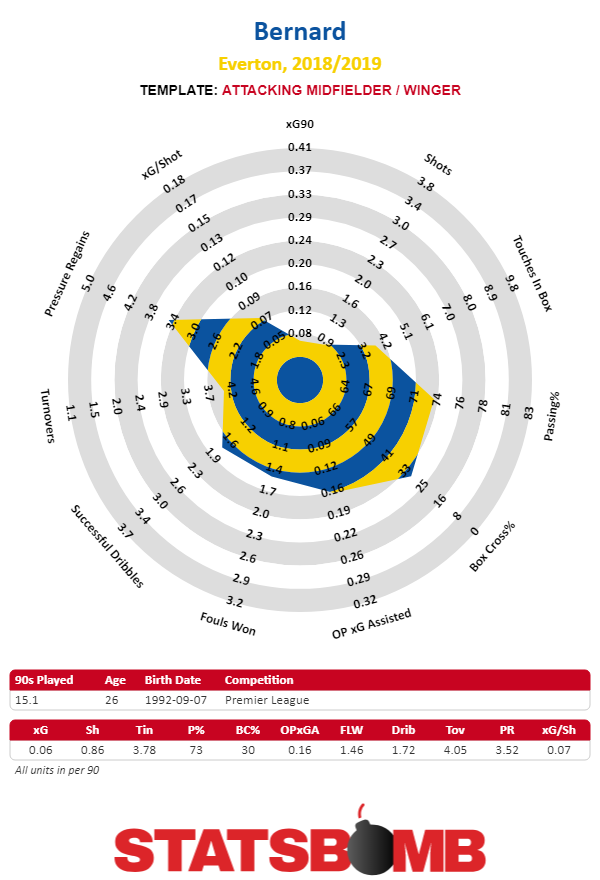
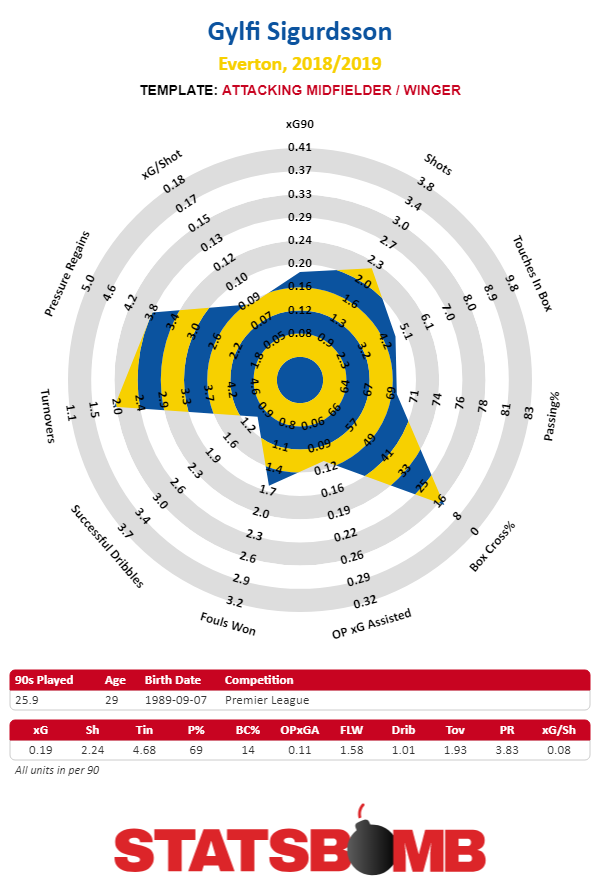
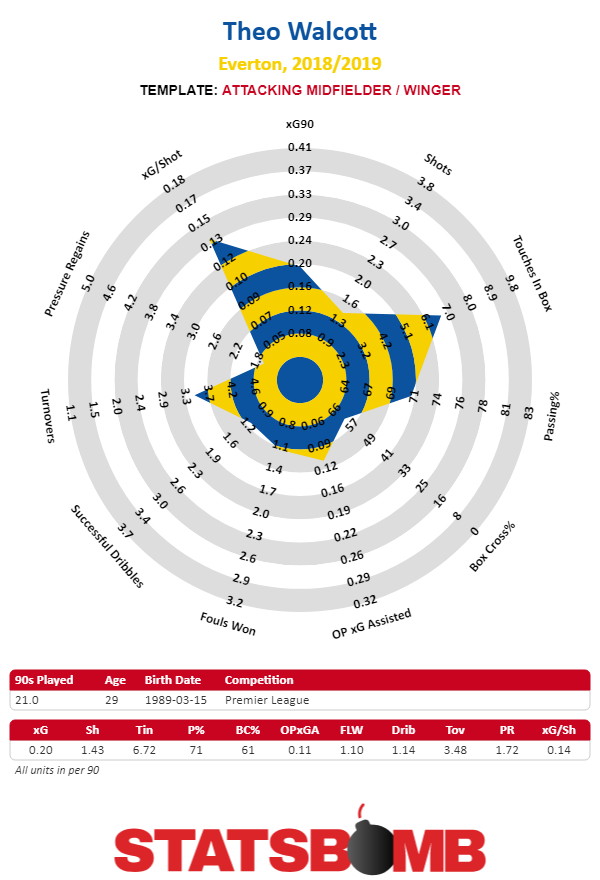 This time the comparison group contains 42 players of attacking midfielders and wingers. Open play expected assists per 90 rank: Bernard: 15/42 Sigurdsson: 25/42 Walcott: 26/42 Open play passes per 90 rank: Bernard: 24/42 Sigurdsson: 37/42 Walcott: 40/42 Opposition final third open play passes per 90 rank: Bernard 27/42 Sigurdsson 34/42 Walcott 37/42 A clear pattern emerges. Everton are extremely direct in attack, particularly Walcott and Sigurdsson, with very few interchanges between the players. When a player gets the ball they go directly for goal or try to play another player in, This is not a group concerned with exchanging passes or recycling possession. In fact we can see this by looking where they each rank among the 42 other attacking midfielders in the proportion of forward passes in the final third: Bernard: 15/42 Sigurdsson: 1/42 Walcott: 13/42 Sigurdsson is a particularly extreme example, topping the comparison chart for the proportion of passes that go forwards when in the final third but also being almost bottom for the volume. In summary he just doesn’t get involved in traditional midfield build up at all. And neither does Theo Walcott or Bernard. The question is whether this is a deliberate tactical ploy, or simply a case of incompatible players failing to link up. If we compare Everton with Wolverhampton Wanderers we see similar numbers in build up play, with Neves and Moutinho profiling similarly to Gomes and Gana. However when the 32 outfield strikers with over 1000 minutes on the pitch are sorted by expected open play assists per 90 minutes Raul Jimenez (3rd) and Diogo Jota (7th) appear a long way before Calvert-Lewin (27th), Cenk Tosun (28th) and Richarlison (31st). If neither the strikers, nor the midfielders are generating high quality chances for each other then you need to consider if the tactical approach is working. So, what exactly is Marco Silva’s tactical approach? He made his name through playing a counter-attacking 4-3-3 formation. It was said of his Olympiakos side that they were so good on the break that they were more dangerous out of possession than in. At Everton, this style of football is yet to click. Playing a 4-2-3-1 without any build up play from the three attacking midfielders, the style often more resembles a 4-2-4, with the only sustained threat coming from the left back where Lucas Digne tops the Everton attacking chart in terms of expected assists. Given the lack of threat from the front four, and the lack of interchange between them, perhaps the best option would be to move one of the attackers back into a standard midfield position and revert to a 4-3-3. The question is; whom? And if the answer is changing formation and dropping an expensive player is the club brave enough to make that decision? Can the team overcome a heavy dose of sunk cost fallacy embodied in the person of Gylfi Siggurdson and make smart, forward looking decisions? The sunk cost fallacy explains that It is painful to accept having wasted money. This pain impedes your ability to make logical decisions. Having invested so much money in Gylfi Sigurdsson it becomes almost impossible for a manager to not play him. And yet the logical change to make to Everton’s line up is moving from a 4-2-3-1 (that actually resembles a 4-2-4) to a 4-3-3. And the logical player to replace is the player currently in the number 10 role who does not contribute to the build up play. Gylfi Sigurdsson. Even without purchasing players Everton’s squad contains central midfield options of Nikola Vlasic, Kieran Dowell, Tom Davies, Morgan Schneiderlin, James McCarthy, Mo Besic, Joe WIlliams, Beni Baningime, and Callum Connolly. With Richarlison, Cenk Tosun, Dominic Calvert-Lewin, Yannick Bolasie, Henry Onyekuru, Kevin Mirallas, and Ademola Lookman fighting for a place in the front three along with Walcott and Bernard. Could Everton control games better, and play better on the break with an additional midfielder offering defensive cover and build up passing? Would a front three of, for example, Bernard, Richarlison and Lookman offer the pace and width in attack Marco Silva made his name coaching? Or could Everton change their style of play and encourage more interchange in attack, and less directness? Bernard showed at Shakhtar Donetsk he can play in a high possession 4-2-3-1, with Walcott and Sigurdsson also having had success at Arsenal and Swansea in teams known for patient build up. There are many questions for Marco Silva to find an answer to by the end of the season. He has options within his - huge - squad. First, however, he’ll have to decide to try something different, and that means accepting that the system he’s used his whole career isn’t working on the pitch at Goodison.
This time the comparison group contains 42 players of attacking midfielders and wingers. Open play expected assists per 90 rank: Bernard: 15/42 Sigurdsson: 25/42 Walcott: 26/42 Open play passes per 90 rank: Bernard: 24/42 Sigurdsson: 37/42 Walcott: 40/42 Opposition final third open play passes per 90 rank: Bernard 27/42 Sigurdsson 34/42 Walcott 37/42 A clear pattern emerges. Everton are extremely direct in attack, particularly Walcott and Sigurdsson, with very few interchanges between the players. When a player gets the ball they go directly for goal or try to play another player in, This is not a group concerned with exchanging passes or recycling possession. In fact we can see this by looking where they each rank among the 42 other attacking midfielders in the proportion of forward passes in the final third: Bernard: 15/42 Sigurdsson: 1/42 Walcott: 13/42 Sigurdsson is a particularly extreme example, topping the comparison chart for the proportion of passes that go forwards when in the final third but also being almost bottom for the volume. In summary he just doesn’t get involved in traditional midfield build up at all. And neither does Theo Walcott or Bernard. The question is whether this is a deliberate tactical ploy, or simply a case of incompatible players failing to link up. If we compare Everton with Wolverhampton Wanderers we see similar numbers in build up play, with Neves and Moutinho profiling similarly to Gomes and Gana. However when the 32 outfield strikers with over 1000 minutes on the pitch are sorted by expected open play assists per 90 minutes Raul Jimenez (3rd) and Diogo Jota (7th) appear a long way before Calvert-Lewin (27th), Cenk Tosun (28th) and Richarlison (31st). If neither the strikers, nor the midfielders are generating high quality chances for each other then you need to consider if the tactical approach is working. So, what exactly is Marco Silva’s tactical approach? He made his name through playing a counter-attacking 4-3-3 formation. It was said of his Olympiakos side that they were so good on the break that they were more dangerous out of possession than in. At Everton, this style of football is yet to click. Playing a 4-2-3-1 without any build up play from the three attacking midfielders, the style often more resembles a 4-2-4, with the only sustained threat coming from the left back where Lucas Digne tops the Everton attacking chart in terms of expected assists. Given the lack of threat from the front four, and the lack of interchange between them, perhaps the best option would be to move one of the attackers back into a standard midfield position and revert to a 4-3-3. The question is; whom? And if the answer is changing formation and dropping an expensive player is the club brave enough to make that decision? Can the team overcome a heavy dose of sunk cost fallacy embodied in the person of Gylfi Siggurdson and make smart, forward looking decisions? The sunk cost fallacy explains that It is painful to accept having wasted money. This pain impedes your ability to make logical decisions. Having invested so much money in Gylfi Sigurdsson it becomes almost impossible for a manager to not play him. And yet the logical change to make to Everton’s line up is moving from a 4-2-3-1 (that actually resembles a 4-2-4) to a 4-3-3. And the logical player to replace is the player currently in the number 10 role who does not contribute to the build up play. Gylfi Sigurdsson. Even without purchasing players Everton’s squad contains central midfield options of Nikola Vlasic, Kieran Dowell, Tom Davies, Morgan Schneiderlin, James McCarthy, Mo Besic, Joe WIlliams, Beni Baningime, and Callum Connolly. With Richarlison, Cenk Tosun, Dominic Calvert-Lewin, Yannick Bolasie, Henry Onyekuru, Kevin Mirallas, and Ademola Lookman fighting for a place in the front three along with Walcott and Bernard. Could Everton control games better, and play better on the break with an additional midfielder offering defensive cover and build up passing? Would a front three of, for example, Bernard, Richarlison and Lookman offer the pace and width in attack Marco Silva made his name coaching? Or could Everton change their style of play and encourage more interchange in attack, and less directness? Bernard showed at Shakhtar Donetsk he can play in a high possession 4-2-3-1, with Walcott and Sigurdsson also having had success at Arsenal and Swansea in teams known for patient build up. There are many questions for Marco Silva to find an answer to by the end of the season. He has options within his - huge - squad. First, however, he’ll have to decide to try something different, and that means accepting that the system he’s used his whole career isn’t working on the pitch at Goodison.
Solskjær’s Manchester United: The Real Deal, or Just a Good Run?
It’s been quite the turnaround for Manchester United since Ole Gunnar Solskjær replaced José Mourinho in December. It seemed impossible to imagine at the tail end of last year that the feeling around Old Trafford could change so quickly. So joyless were Mourinho’s final months, that felt like this was all United were. Enter Solskjær. He’s won eleven out of thirteen games, making everyone reminisce over the memories of swashbuckling sides managed by Sir Alex Ferguson. As of writing this, the betting markets have the Norwegian as the odds on favourite to become the next United manager. Granted, the defeat to a much better Paris Saint-Germain has taken the shine off things, making now a good time to look at how things are actually going, and whether Solskjær might be capable of continuing this good form in the long term.
How Has Solskjær Changed United’s Approach?
Sometimes the pub narratives aren’t wrong. United are attacking a lot more under the new boss. Under Mourinho this season, the side were generating 1.29 expected goals per 90, a figure that has risen to 1.64 since Solskjær’s arrival. Not only are they taking about two extra shots per game, but they are taking better shots, with each having an estimated 11% chance of going in, compared to 9% under Mourinho. These don’t sound like huge differences, but the edges add up significantly. 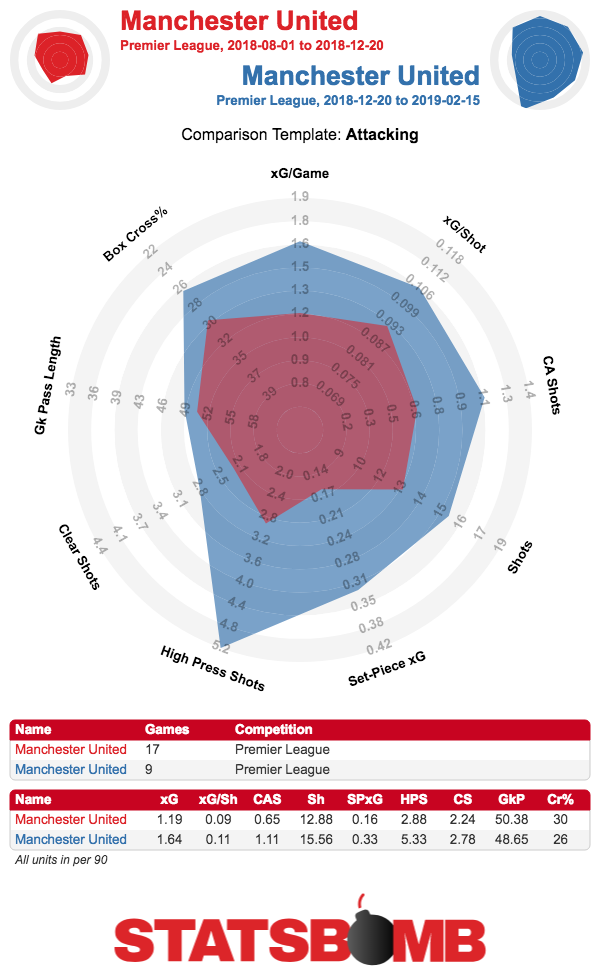 The most striking thing from the attacking team radars, other than an across the board improvement, is that United are taking nearly twice as many high press shots (“shots from possessions that were won within 5 seconds of a defensive action”) and counter attacking shots (“within 15 seconds of a possession that originates in the opposition’s own half”) as before. That mostly captures what everyone can see with their own eyes: Solskjær’s United are a higher pressing, faster breaking team than during Mourinho’s tenure. The way United are doing this isn’t all that tactically complex. Solskjær has stuck to a narrow 4-3-3 system, with a preferred attacking trio of Marcus Rashford, Jesse Lingard and Anthony Martial. While there have been certain situations where Lingard’s pressing has been favoured upfront, it’s generally been Rashford leading the line as the striker. And it’s fair to say that’s worked out pretty well so far.
The most striking thing from the attacking team radars, other than an across the board improvement, is that United are taking nearly twice as many high press shots (“shots from possessions that were won within 5 seconds of a defensive action”) and counter attacking shots (“within 15 seconds of a possession that originates in the opposition’s own half”) as before. That mostly captures what everyone can see with their own eyes: Solskjær’s United are a higher pressing, faster breaking team than during Mourinho’s tenure. The way United are doing this isn’t all that tactically complex. Solskjær has stuck to a narrow 4-3-3 system, with a preferred attacking trio of Marcus Rashford, Jesse Lingard and Anthony Martial. While there have been certain situations where Lingard’s pressing has been favoured upfront, it’s generally been Rashford leading the line as the striker. And it’s fair to say that’s worked out pretty well so far. 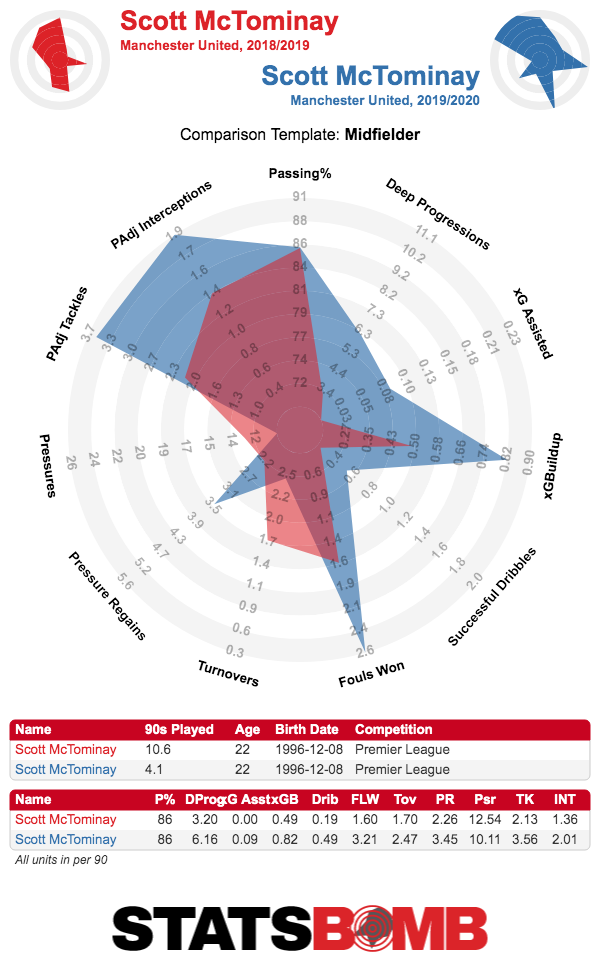 This is the first time in Rashford’s still very young career that his obvious talent has been met with a high level of shot production. The cynic would say that such a dramatic improvement is bound to be a blip, and that could well prove to be the case. But, there’s certainly an optimistic case for his form. This is the first time in the England international’s senior career that he’s played in a United team that wasn’t frustratingly conservative, and a relatively rare period of him being free of an “out and out” striker such as Romelu Lukaku or Zlatan Ibrahimović. His shot volume is certainly something to watch out for over the rest of the season. Fellow attackers Martial and Lingard have also been in good form, though the improvement has been more modest than Rashford’s.
This is the first time in Rashford’s still very young career that his obvious talent has been met with a high level of shot production. The cynic would say that such a dramatic improvement is bound to be a blip, and that could well prove to be the case. But, there’s certainly an optimistic case for his form. This is the first time in the England international’s senior career that he’s played in a United team that wasn’t frustratingly conservative, and a relatively rare period of him being free of an “out and out” striker such as Romelu Lukaku or Zlatan Ibrahimović. His shot volume is certainly something to watch out for over the rest of the season. Fellow attackers Martial and Lingard have also been in good form, though the improvement has been more modest than Rashford’s. 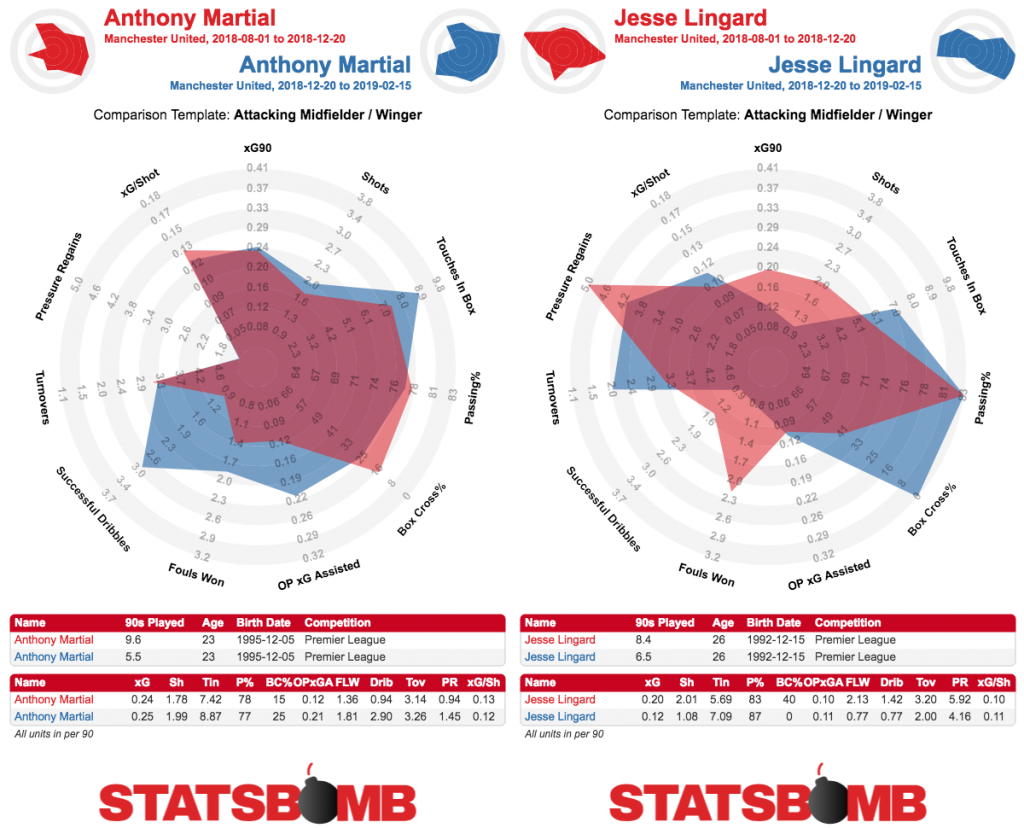 The most discussed player, though, is always Paul Pogba. The Frenchman’s time under Mourinho received a lot of criticism and its fair share of defenders. For the first two years of his United career he played largely as a sitting midfielder in a broad 4-2-3-1 shape, with Mourinho seeming to envision him having the same impact Cesc Fàbregas had as a deep-lying playmaker in the manager’s Chelsea side. This involved having to curb his natural instincts to move into the final third and join the attack, and while France managed to successfully do this in the World Cup, Pogba had N’Golo Kanté as a midfield partner to cover him. At United, he initially had Ander Herrera, himself more of a natural box-to-box player anyway, and then Nemanja Matić, ideal for the role in his prime but seemingly no longer able to cover the ground required. Thus, the double pivot had a hard time controlling the game, something for which Pogba received a lot of criticism. Mourinho’s fix for this was a three man midfield, which in theory should have got the most out of Pogba, but his consistent off-field feuds left the Frenchman often either in a restrained and unnatural role or simply not on the pitch.
The most discussed player, though, is always Paul Pogba. The Frenchman’s time under Mourinho received a lot of criticism and its fair share of defenders. For the first two years of his United career he played largely as a sitting midfielder in a broad 4-2-3-1 shape, with Mourinho seeming to envision him having the same impact Cesc Fàbregas had as a deep-lying playmaker in the manager’s Chelsea side. This involved having to curb his natural instincts to move into the final third and join the attack, and while France managed to successfully do this in the World Cup, Pogba had N’Golo Kanté as a midfield partner to cover him. At United, he initially had Ander Herrera, himself more of a natural box-to-box player anyway, and then Nemanja Matić, ideal for the role in his prime but seemingly no longer able to cover the ground required. Thus, the double pivot had a hard time controlling the game, something for which Pogba received a lot of criticism. Mourinho’s fix for this was a three man midfield, which in theory should have got the most out of Pogba, but his consistent off-field feuds left the Frenchman often either in a restrained and unnatural role or simply not on the pitch. 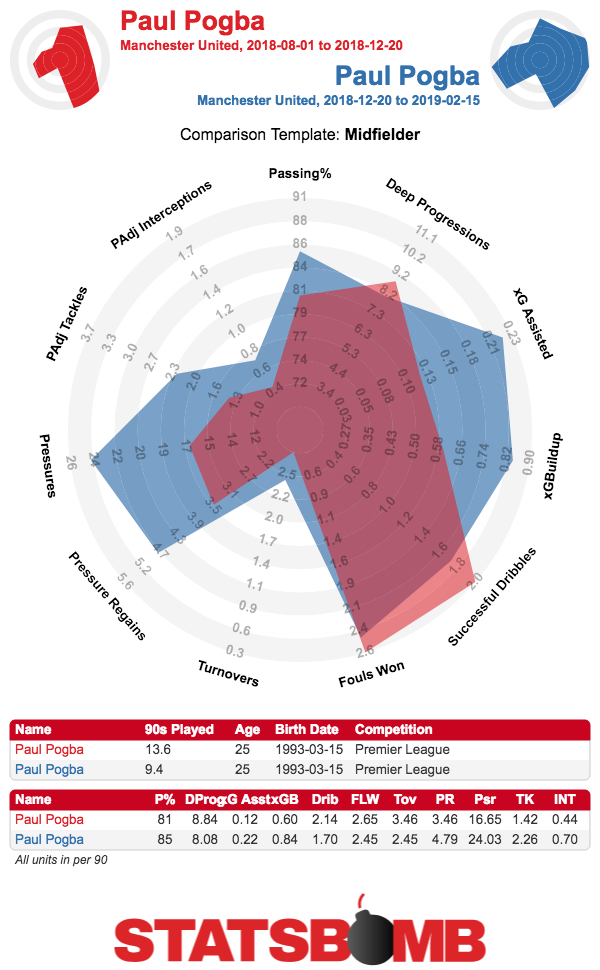 Surely the most straightforward decision Solskjær made was to let Pogba play his preferred game. As the most advanced player in a midfield three, Pogba has been encouraged to arrive in the box and join in with the attack where possible. He’s getting more touches in the box and more shots since the Norwegian took over. Surprisingly, his defensive workload has also increased, though this may also reflect on the more front foot approach under Solskjær. His deep progressions and dribbles have fallen a touch, perhaps illustrating that he is no longer being asked to dictate the game from deep. There are some out there who consider this a downgrade, with StatsBomb contributor Paul Riley calling his new role a “criminal waste of talent and game control”. There is also a question of whether the two deeper midfielders, Herrera and Matić, offer enough on the ball to help dictate things, with PSG showing that United have a hard time generating chances when Pogba is nullified. What it’s hard to deny, though, is Pogba’s effectiveness when breaking into the final third. He remains capable of sublime moments of individual quality while also combining with the other attackers much more fluently. He’s good at football.
Surely the most straightforward decision Solskjær made was to let Pogba play his preferred game. As the most advanced player in a midfield three, Pogba has been encouraged to arrive in the box and join in with the attack where possible. He’s getting more touches in the box and more shots since the Norwegian took over. Surprisingly, his defensive workload has also increased, though this may also reflect on the more front foot approach under Solskjær. His deep progressions and dribbles have fallen a touch, perhaps illustrating that he is no longer being asked to dictate the game from deep. There are some out there who consider this a downgrade, with StatsBomb contributor Paul Riley calling his new role a “criminal waste of talent and game control”. There is also a question of whether the two deeper midfielders, Herrera and Matić, offer enough on the ball to help dictate things, with PSG showing that United have a hard time generating chances when Pogba is nullified. What it’s hard to deny, though, is Pogba’s effectiveness when breaking into the final third. He remains capable of sublime moments of individual quality while also combining with the other attackers much more fluently. He’s good at football.
Can United Keep This Up?
One concern concern when watching Solskjær’s side is in how willing they are to push players forward. The commitment to attacking football without a clear, deliberate structure has often made United appear somewhat easy to hit on the counter. Of course, they have only conceded 5 non-penalty goals in the league. To understand how, we just need to take a look David de Gea, once again proving to be the team’s defensive cheat code. 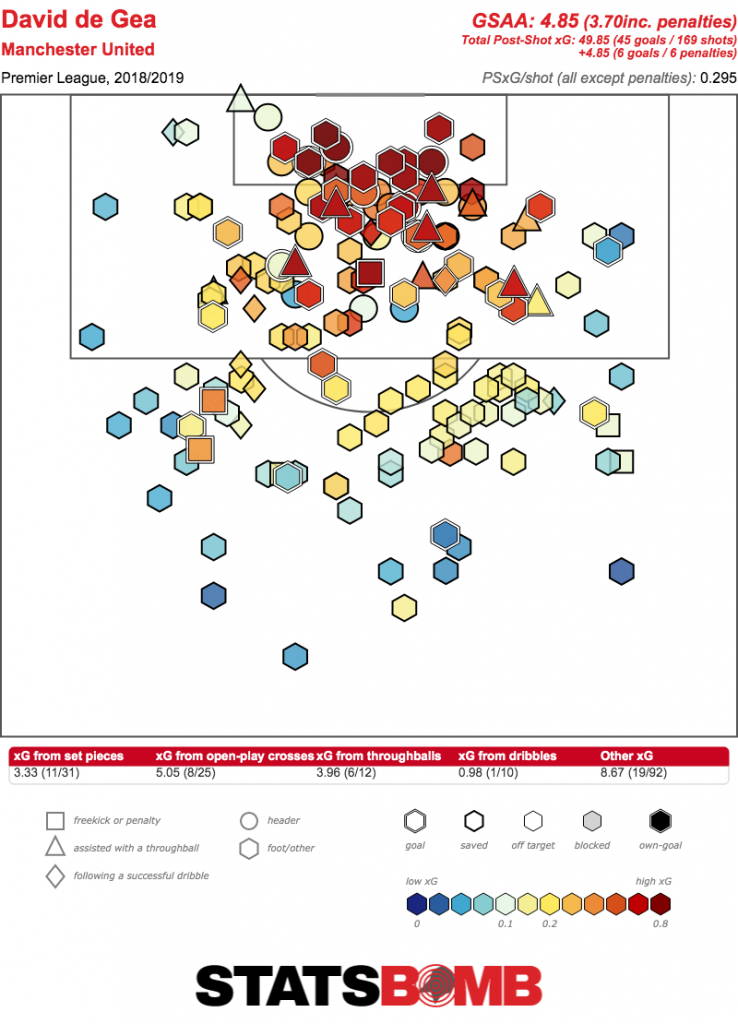 The post-shot xG model would expect the Spaniard to have conceded on average 9.28 non-penalty goals in the league since Solskjær arrived. He’s conceded slightly over half that many (plus the one penalty he faced). He is well and truly back in the form that earned him so many plaudits last season. You don’t even have to defend well when he’s in the zone like this. Can he maintain it? Everyone regresses to the mean at least somewhat over the long term. De Gea, though, is probably the best shot stopper on the planet, so one should likely expect at least a degree of overperformance going forward. On the attacking side, United have scored 19 non-penalty goals from an expected haul of 14.78 (as well as scoring all 4 of the penalties they have won). This isn’t a huge difference, so alarm bells shouldn’t be sounding, but with no obvious explanation in the way De Gea can describe things on the defensive end, the expectation should probably be that United will conform to their attacking numbers going forward. The biggest stick with which Solskjær has been beaten is the schedule he’s faced so far. The 9 league opponents since his arrival have an average position in the table of 14th. United won their lone legitimately tough league game so far, away to Tottenham 1-0, but the numbers suggest that wasn’t the strongest performance.
The post-shot xG model would expect the Spaniard to have conceded on average 9.28 non-penalty goals in the league since Solskjær arrived. He’s conceded slightly over half that many (plus the one penalty he faced). He is well and truly back in the form that earned him so many plaudits last season. You don’t even have to defend well when he’s in the zone like this. Can he maintain it? Everyone regresses to the mean at least somewhat over the long term. De Gea, though, is probably the best shot stopper on the planet, so one should likely expect at least a degree of overperformance going forward. On the attacking side, United have scored 19 non-penalty goals from an expected haul of 14.78 (as well as scoring all 4 of the penalties they have won). This isn’t a huge difference, so alarm bells shouldn’t be sounding, but with no obvious explanation in the way De Gea can describe things on the defensive end, the expectation should probably be that United will conform to their attacking numbers going forward. The biggest stick with which Solskjær has been beaten is the schedule he’s faced so far. The 9 league opponents since his arrival have an average position in the table of 14th. United won their lone legitimately tough league game so far, away to Tottenham 1-0, but the numbers suggest that wasn’t the strongest performance. 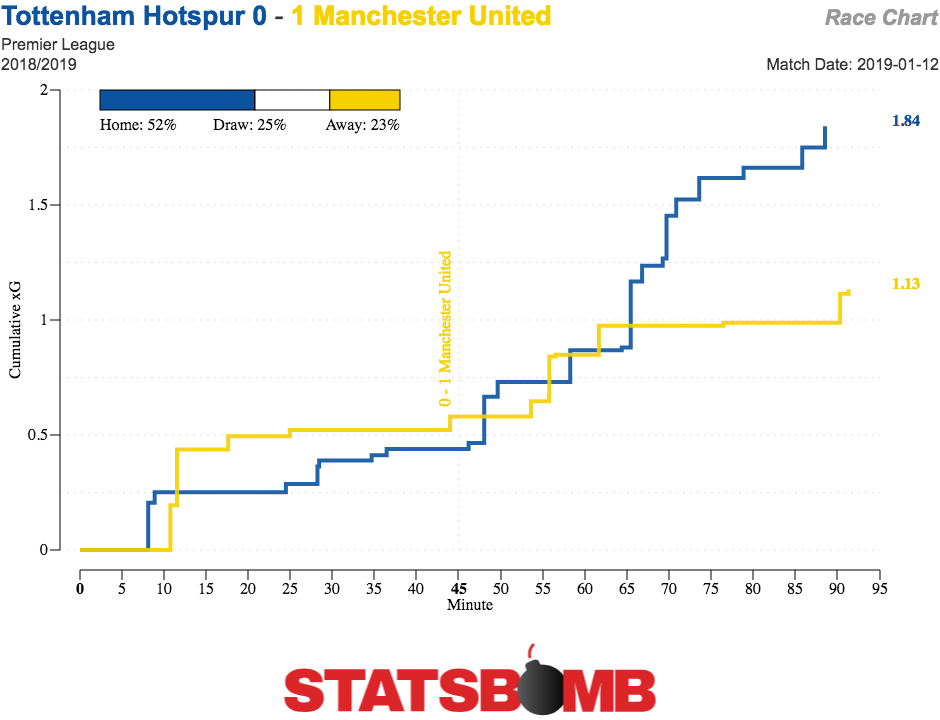 After going ahead just before the break, United were totally unable to soak up Spurs’ pressure in the second half, conceding chance after chance and relying on De Gea to pull off a series of spectacular saves. They got the three points, yes, but to claim it as any kind of successful performance requires strong outcome bias. The story was worse at home to PSG.
After going ahead just before the break, United were totally unable to soak up Spurs’ pressure in the second half, conceding chance after chance and relying on De Gea to pull off a series of spectacular saves. They got the three points, yes, but to claim it as any kind of successful performance requires strong outcome bias. The story was worse at home to PSG. 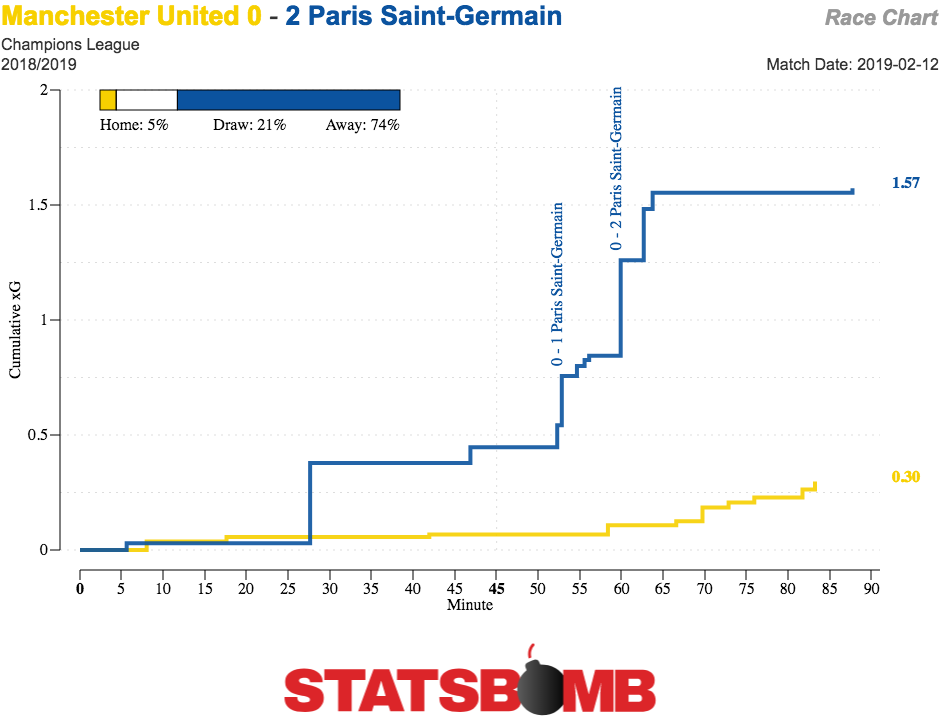 When you play a tactic largely of committing players forward against a team with Kylian Mbappé, you’re at risk of conceding. What might be more concerning is how little United offered going forward. Looking at their shot map, there was a huge empty space right in front of goal.
When you play a tactic largely of committing players forward against a team with Kylian Mbappé, you’re at risk of conceding. What might be more concerning is how little United offered going forward. Looking at their shot map, there was a huge empty space right in front of goal. 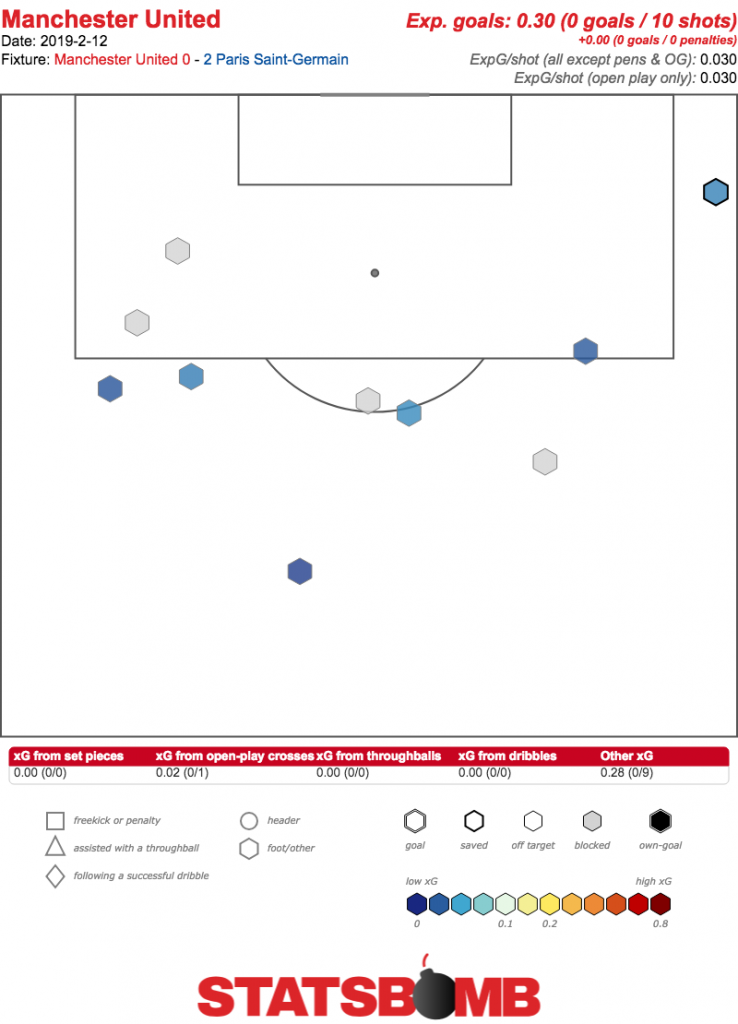 Why were United so bereft of attacking impetus? A certain Arsène Wenger had a theory. “What Paris Saint-Germain did”, Wenger claimed, “is they blocked Pogba with Marquinhos in man-to-man marking”. This was effective because Solskjær’s team “cannot build the game up, especially at the back. They cannot make good passes into midfield. Man United has a real lack of ideas to build the game”. In his time in charge, Solskjær’s attacking structure has been focused simply on giving the ball to Pogba, and letting him and the front three make penetrating runs. It is not obvious that he has a clear idea of how he wants his side to break down opponents. Things were admittedly brighter in the FA Cup win over Chelsea. Maurizio Sarri’s team attempted to play their usual possession-heavy approach and found themselves fairly easily exposed by United’s counter-attacking threat, with Chelsea having no clear plan for dealing with Pogba and allowing the Frenchman to dominate the game. There were concerns, though, particularly in the second half, with much of the game being played in United’s own half as Solskjær’s side looked unable to kill off the game. It was most likely a deserved win, though not an emphatic one, with the result arguably speaking more to Chelsea’s weaknesses than United’s strengths. All of this is fine if Solskjær is merely the interim manager. United were bad at the end of Mourinho’s reign. The players were unhappy. Everything at Old Trafford felt negative. Solskjær has come in and transformed the atmosphere, playing enjoyable if straightforward football and getting good results, even if there has been an element of good fortune about it. In terms of the road ahead, though, United may require a manager with more complex methods than what we’ve seen in recent months. Perhaps Solskjær has shades to him that we have not yet seen. If he is to become the permanent manager, he will need to have them. Header image courtesy of the Press Association
Why were United so bereft of attacking impetus? A certain Arsène Wenger had a theory. “What Paris Saint-Germain did”, Wenger claimed, “is they blocked Pogba with Marquinhos in man-to-man marking”. This was effective because Solskjær’s team “cannot build the game up, especially at the back. They cannot make good passes into midfield. Man United has a real lack of ideas to build the game”. In his time in charge, Solskjær’s attacking structure has been focused simply on giving the ball to Pogba, and letting him and the front three make penetrating runs. It is not obvious that he has a clear idea of how he wants his side to break down opponents. Things were admittedly brighter in the FA Cup win over Chelsea. Maurizio Sarri’s team attempted to play their usual possession-heavy approach and found themselves fairly easily exposed by United’s counter-attacking threat, with Chelsea having no clear plan for dealing with Pogba and allowing the Frenchman to dominate the game. There were concerns, though, particularly in the second half, with much of the game being played in United’s own half as Solskjær’s side looked unable to kill off the game. It was most likely a deserved win, though not an emphatic one, with the result arguably speaking more to Chelsea’s weaknesses than United’s strengths. All of this is fine if Solskjær is merely the interim manager. United were bad at the end of Mourinho’s reign. The players were unhappy. Everything at Old Trafford felt negative. Solskjær has come in and transformed the atmosphere, playing enjoyable if straightforward football and getting good results, even if there has been an element of good fortune about it. In terms of the road ahead, though, United may require a manager with more complex methods than what we’ve seen in recent months. Perhaps Solskjær has shades to him that we have not yet seen. If he is to become the permanent manager, he will need to have them. Header image courtesy of the Press Association
Messi's Big Game
It's fair to say that Lionel Messi remains the best player in the world. This past weekend, he contrived to put together a fascinating and unique performance. Barcelona eked a 1-0 win out against Real Valladolid, with one goal a small return from twenty shots, two of which were Messi penalties. Barcelona regularly take twenty or more shots, and this was the eighth time they've done it in La Liga this season. What was unusual was Messi's involvement. Of 20 shots, he took 12 of them and laid on the key pass for 7 others. It's been widely reported that he was involved in all 20, but that's simply not true as late in second half stoppage time Philippe Coutinho ruined everything by propelling a non-Messi influenced ball high into the stands, and a shot's a shot, so that was that. But that doesn't change the fundamental measurement of the accomplishment. Here at StatsBomb Towers, we dusted off the microfilm and took a look through the history to find any kind of equivalent game. My initial feeling was that this was a scarce performance; sure, players take double digit shots in a game and there are many games on record with over 30 shots for a team and a forward loading up double digit shots. The true rarity of this accomplishment is for a player to be so singularly involved in a team's attack. It would make more sense if it was say, an aging Argentina side desperately lumbering against Iceland in the 2018 World Cup (Messi shot 11 times and logged 3 key passes that day, but that was just 50% of 28 total shots), but for a team like Barcelona, to funnel everything through their talisman felt unusual. And it was. To be directly involved in 95% of a team's shots is as extremely rare, especially with any significant volume of team shots. To be involved in all but one of 20 shots is off the charts. Just hasn't happened. 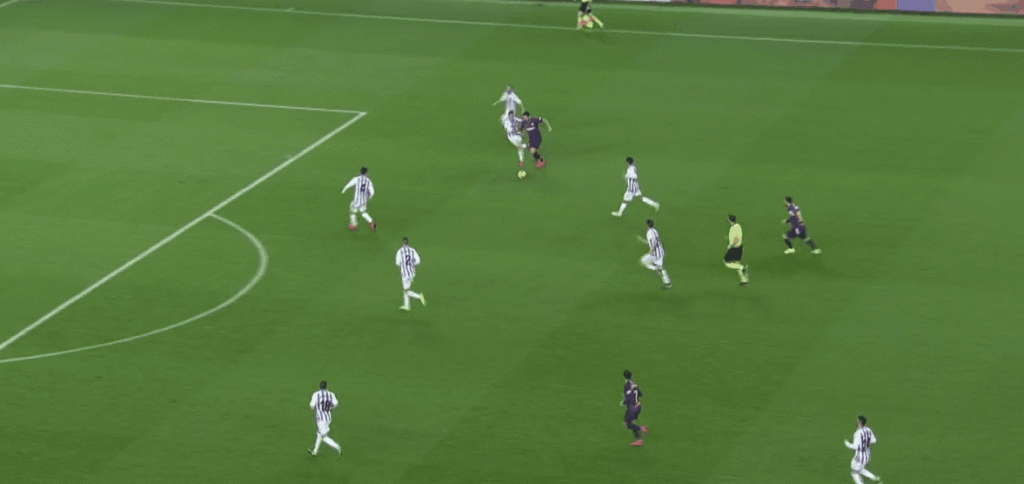
StatsBomb Podcast: February 2019 #4, CL Preview & Mega 2018-19 Player Stats Review
Details on Our New Intro to Analytics and Set Piece Courses
A couple of weeks ago, we announced on our social media that we would be launching an Intro to Analytics for Football Professionals course here at our offices in Bath, England.
The idea behind the course is that analytics and data use is becoming more and more important in both the team and media spaces and there are currently a dearth of good places to learn this information from scratch. Coaches need this info. Analysts need this info. Pundits need this info (please jesus, let the pundits realise this). Future coaches and analysts need this info! Thus it makes sense for us to develop teaching material to fill the gap. There's a bit of risk here, because developing a full day of course materials is about a 6-week project for a single analyst, and honestly, we don't know if we're right. What if no one actually wants to attend this course?
On the other hand, it makes a ton of sense for us to teach it. We have been pioneers in this space since 2013, we have our own data for students to leverage, our own cutting edge analytics platform to use during courses, and have actually worked inside of football for teams both very small, and very very large. We also feel like there will be a shortage of qualified analysts for teams to hire as more transition from no data analysis to heavy data analysis, and we need to help pick up the slack.
The initial course offering of thirty slots filled in five days.
Okay then, demand question (mostly) settled.
We also received a flood of questions about when we would offer more courses and where we would offer them (London, Germany, Spain, the U.S., Australia, online)? Baby steps!
After about ten days of trying to find venues that made sense, we have now locked down space to host two fresh classes in London in June.

PLEASE SIGN UP FOR THE INTRODUCTORY COURSE HERE.
Along with the Introductory course we previously announced, we will also begin teaching a new course focused on Set Piece Design and Analysis.
First we broke Denmark. Now we're going to help all of you break the rest of football.
Our Set Pieces offering is a practical course designed for football/soccer coaches and analysts to learn how to get the most out of this undervalued phase of the game. In one day, we will present the building blocks for the success we have had executing set pieces at the professional level.
I don't believe there is anything else like it.
Given how many people ask me on a weekly basis if I can give them more info on how to improve their set pieces, and how many professional clubs have already expressed an interest in this new course, I suspect demand here will be high and spaces will fill quickly.
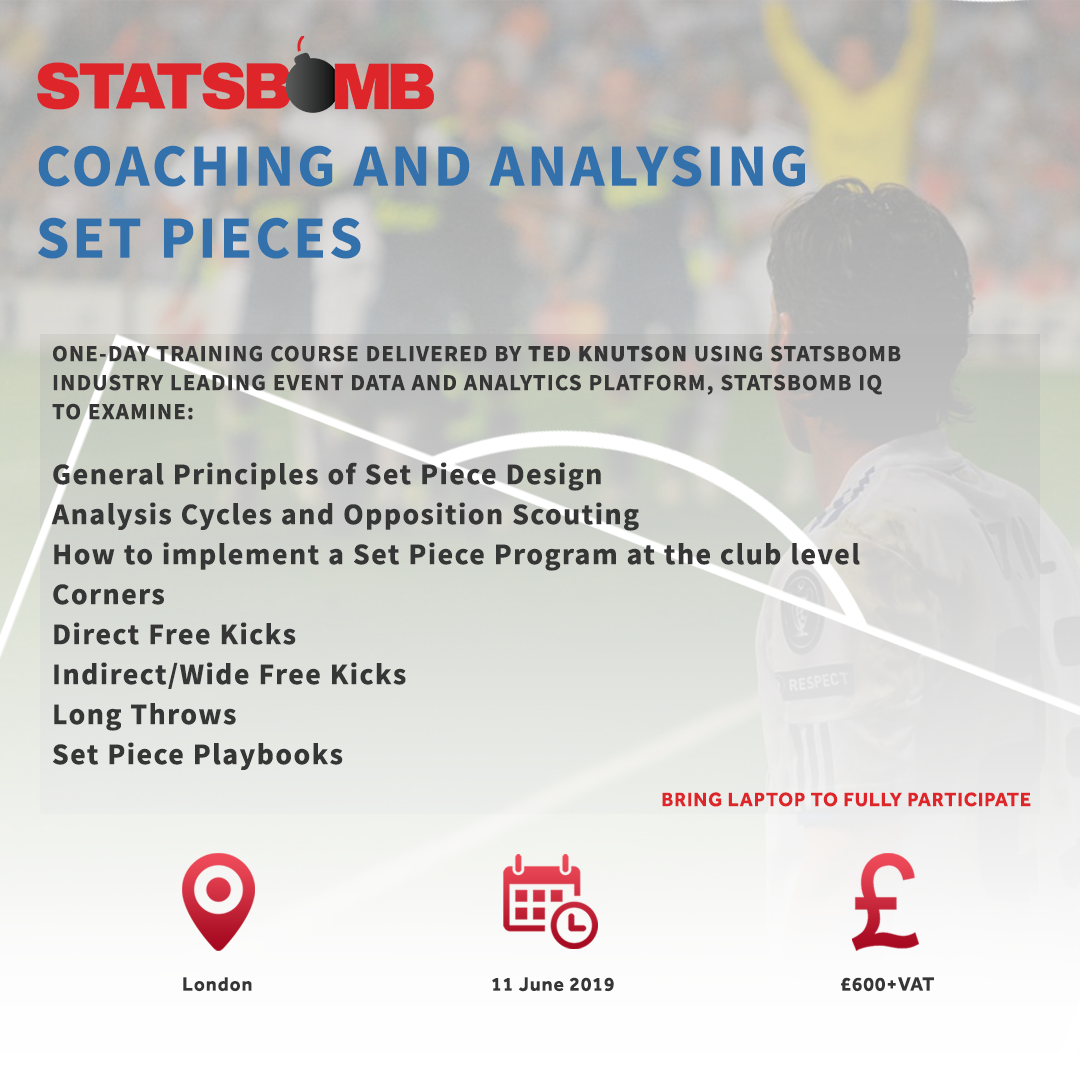
PLEASE SIGN UP TO THE SET PIECES COURSE HERE.
What's Next?
If the London courses fill quickly, we will begin looking for space to run additional Introduction and Set Piece courses outside the U.K. We will potentially do a U.S. tour this summer in major cities, plus Barcelona and Madrid (en espanol), and somewhere in central Germany, but everything depends on whether there is enough interest in these London courses to expand. You guys seem excited, but as usual, I could be wrong.
Alongside the next set of courses we announce, we will also build a new page on our website to better keep track of our education schedule.
Those of you who listen to our podcast also know that I teased the concept of building a Data-Based Recruitment course that we may do a few times a year, and it's possible we will do something very high end on data infrastructure, data visualisation, and programming somewhere down the road.
Football is in a significant period of change right now, and I'm genuinely happy StatsBomb is at the forefront of that change, while teaching people skills they will need to succeed in the future. Given the feedback we've had about our education initiative thus far, you guys are happy we're here too.
Ted Knutson
CEO, StatsBomb
ted@statsbomb.com
